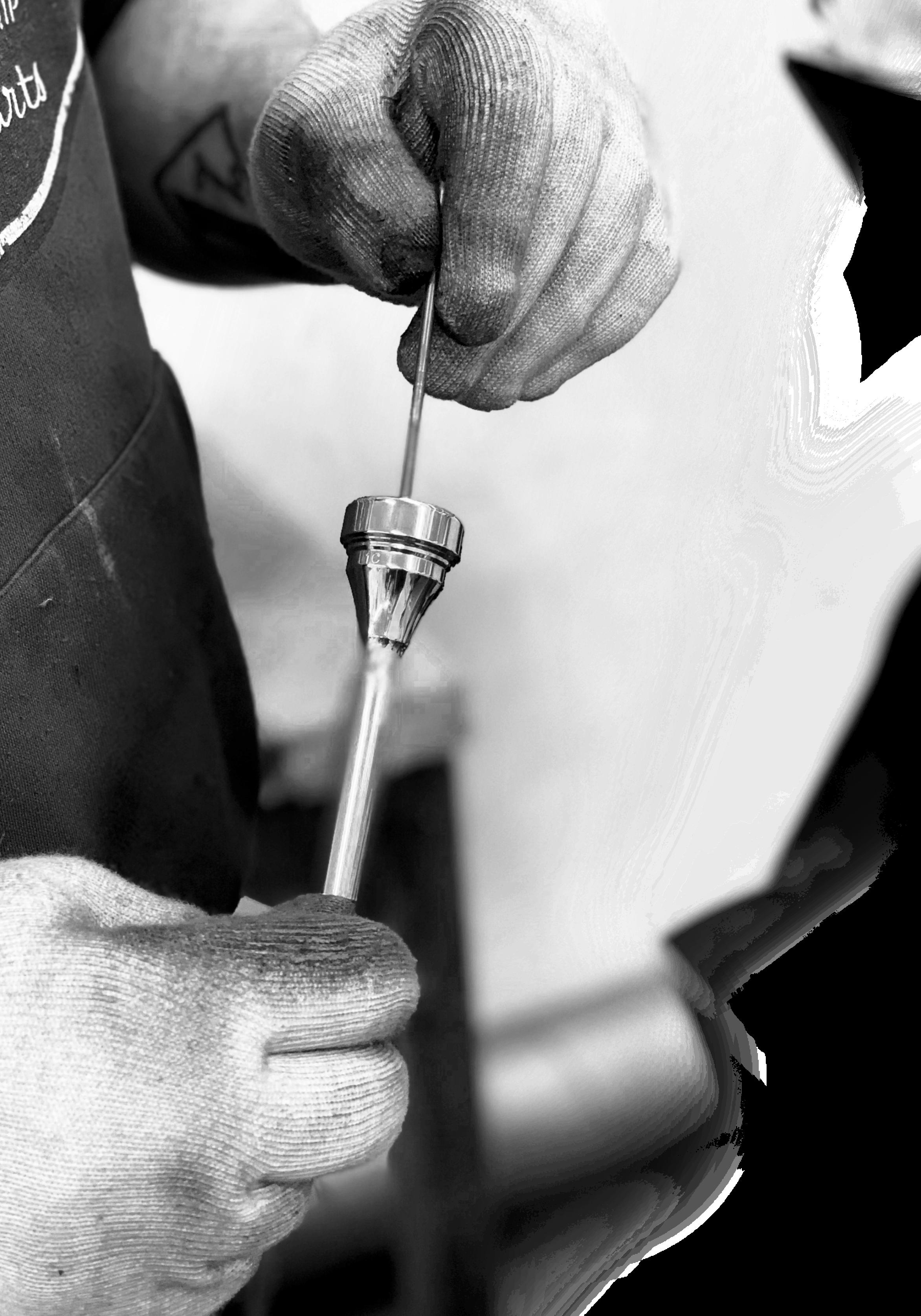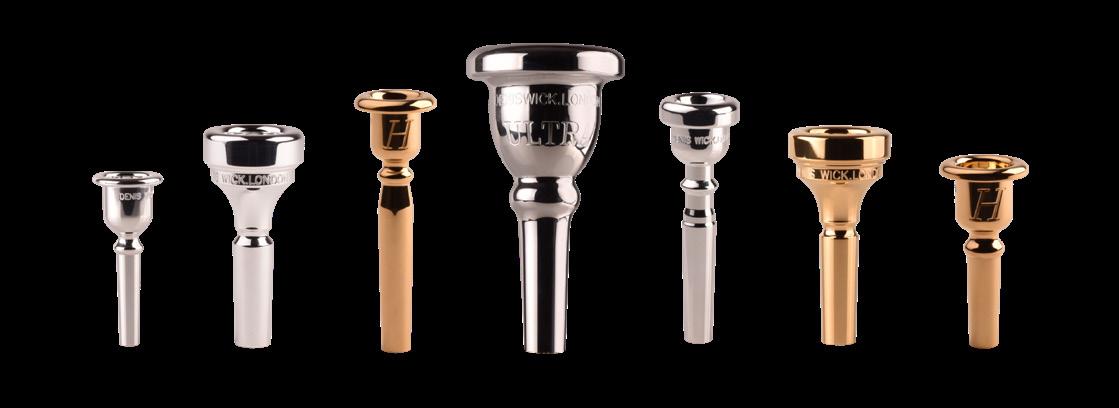The Trombonist



There is plenty on offer to members of the British Trombone Society. You will gain free or discounted entry to our events and access to bonus online content including recordings and our exclusive music library. We have teamed up with a variety of companies who offer exclusive discounts to our members.
This magazine, The Trombonist, is a central part of our membership package and is published three times a year, celebrating the variety of trombone related news and activity across the world.
Membership starts at just £22 a year, with a handful of options for you to choose from. Sign up online, HERE.
Gramophone – claim your 10% discount on subscriptions.
International Trombone Association – special membership rate of £21.
Jazzwise, Europe's leading English language Jazz magazine – 10% discount on subscriptions.
INSURERS
Allianz Musical Insurance – 15% off a new policy for our members – (that's more discount than with an MU membership!)
New Moon Insurance – one month discount on specialist Trombone and musical instrument ‘Harmonic’ insurance products.
Michael Rath – discount of 15% on all trombone repairs and servicing.
Jürgen Voigt Brass – discount of 15% on all trombone repairs and servicing
Hearing ReSolutions – 10% discount on RRP's for protection products.
Warwick Music – 10% discount on all Warwick Music publications purchased directly from Warwick Music.
Prozone Music – an automatic 10% discount on accessories online, plus preferential rates on selected instruments in-store.
Minchin Music – £2 off the list price of ‘Tune In To Tenor’ tutorial book. 10% discount at Callum Au Music
Access to our Members’ Music Library which includes arrangements and transcriptions
BTS IS NOW REGISTERED FOR Gift Aid
Rates
Regular £28
Concession £22 *
Under 16 £10
Institutional £99
Lifetime £250
*Available to students in full-time education, those retired and for seniors aged 65 and over
by
BurtRhodes and Rob Egerton Jazz Transcriptions, plus our library of trombone choir and ensemble arrangements for use at your event (see conditions of use in the respective libraries).
Hercules Stands – 50% discount on the retail price of all Hercules Stands products.
EVEN MORE
Morrison Ward Associates –specialist mortgage advisors.
Image 1st – a generous discount worth £50 to use with this London based photography company.
Q-Park – an additional 10% off prebooking discounted rates in car parks across the UK.
Donating through Gift Aid means charities can claim an extra 25p for every £1 you give. It won’t cost you any extra. To make your declaration, log on and amend your profile on our website, download a declaration form and send to the Administrator or simply send an email to the same address requesting the check box(s) to be ticked for you.
FOR DETAILS OF HOW TO OBTAIN THESE EXCLUSIVE DISCOUNTS, PLEASE VISIT OUR WEBSITE.
HTTP://WWW.BRITISHTROMBONESOCIETY.ORG/MEMBERSHIP/
I trust you are all enjoying some time either resting or banking some practice hours over the summer period.
Thank you to all the members who got involved with International Trombone Week. We have such a strong community of trombone players in the UK, and it is great to celebrate this online or in person. I hope to see many of you at ‘Come and Play Two’ in London in October and if you can’t make it to London, watch out for one of the regional events currently being planned.
A big congratulations must go to our own Carol Jarvis on becoming the International Trombone Association President and to Dudley Bright on being awarded the ITA Neill Humfeld Award for Excellence in Trombone Teaching.
Congratulations also go to Ian Schwalbe on winning first prize in our Composers’ Competition. We are busy planning the next British Trombone Festival, to be held in October 2024, when our performance competitions will be held.

By the time of publication, our instrument loans and bursaries for this year will have been given out. I am personally very proud that the Society can help members in need of assistance and support.
Finally, the Committee is striving to do as much for our members as possible. We are working hard on a project to build an up-to-date resource of grade exam recordings and also redeveloping our website to make sure it meets modern security standards.
As always, please do get in touch below if there is anything I can help you with.
Enjoy your practice!
Welcome to the Summer 2023 issue of The Trombonist. This issue has something of a Trans-Atlantic theme; acclaimed American trombonist Scott Hartman is interviewed by members of the National Youth Brass Band of Great Britain, we share news from the International Trombone Association and of British participation in the International Trombone Festival 2023, held in Salt Lake City, and congratulate the winners of this year’s BTS Composers’ Competition, all of whom hail from the USA.
Closer to home we report on another very successful Durham Trombone Day, the BTS contribution to International Trombone Week and speak with several of the trombone players who performed at the Coronation of Their Majesties King Charles III and Queen Camilla.
Elsewhere we review a new book demystifying the French horn (yes, the French horn!) by Richard Stegall, my counterpart at the British Horn Society, mark the launch of Kris Garfitt’s debut album and celebrate the release of Windows, with the chance to win your very own copy.
Among our regular features joint BTS North East Representative David Thornber reflects on his experiences with Focal Dystonia and Simon Minshall answers members’ questions.
Finally, bumper News and What’s On sections attest to a strong and vibrant trombone community, both at home and abroad.
Simon Minshall president@britishtrombonesociety.org Alastair Warren editor@britishtrombonesociety.org
EDITOR
Alastair Warren editor@britishtrombonesociety.org
SUB-EDITORS
Peter Chester and Alison Keep
NEWS EDITOR news@britishtrombonesociety.org
EVENTS EDITOR events@britishtrombonesociety.org
REVIEWS EDITOR
Jane Salmon reviews@britishtrombonesociety.org
ADVERTISING MANAGER
Chris Valentine advertising@britishtrombonesociety.org
SOCIAL MEDIA MANAGER
Martin Lee Thompson content@britishtrombonesociety.org
MAGAZINE
14
CONTRIBUTORS TO THIS ISSUE
Alastair Warren
Simon Minshall
Tom Pilsbury
David Thornber
Peter Chester
Steph Shore
Josh Cirtina
Becky Smith
Dr Brett Baker
Katy Jones
Adam Warburton
Jennifer Ewington
Malachy Cullen



The London Symphony Orchestra has appointed Jonathan Hollick as their new Sub-Principal Trombone.

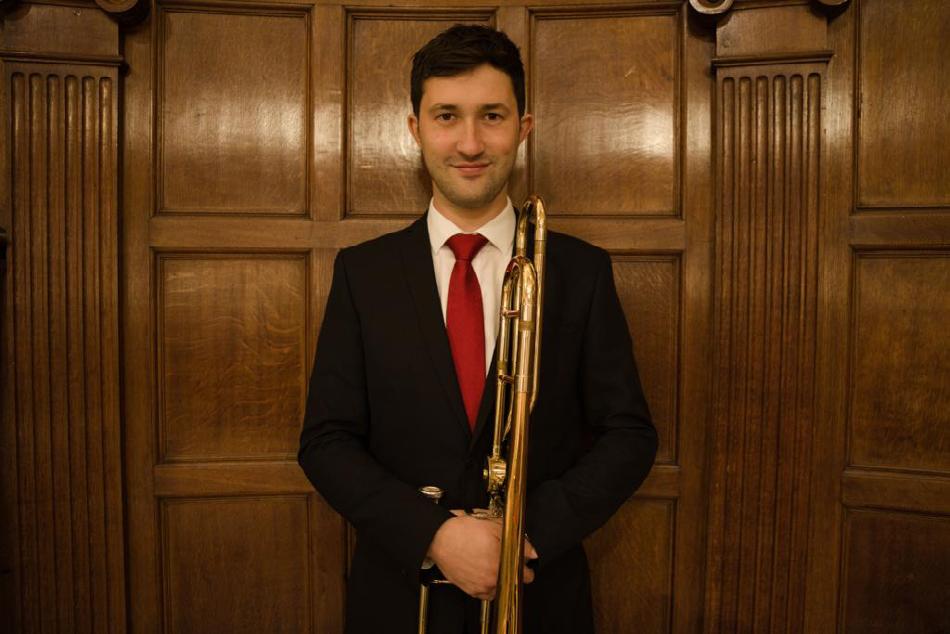
The Orchestra of Opera North has appointed Tom Berry as Principal Second Trombone.
Hailing from the North West town of Westhoughton, Tom began his musical journey through the peripatetic music service in Bolton.
After studying at Chetham’s School of Music with Phil Goodwin, Rob Burtenshaw (Opera North's previous Second Trombone) and Billy Millar, he then went on to study as an ABRSM scholar at the Royal College of Music, learning with Lindsey Shilling and Byron Fulcher.
Jonathan grew up in Plymouth, Devon where he started playing the trombone at the age of 13. He played in his father's youth band for the majority of his childhood, as well as playing for bands in Cornwall. In 2011 Jonathan began his studies at the Royal College of Music, London where he spent 6 years, learning with Byron Fulcher, Lindsay Shilling and Amos Miller.
In Jonathan’s first year out of the RCM, he won the Principal Second Trombone chair at the BBC Scottish Symphony Orchestra in Glasgow, of which he has been a member for the last 5 years, performing around Europe, Japan and at the BBC proms in the Royal Albert Hall. He has also been an active freelancer with many of the UK's finest orchestras.
In his spare time, he loves to play various sports such as snooker, badminton, and football, and he is a big, if frustrated, Manchester United fan.
Jonathan takes up his post in the LSO in October alongside Peter Moore and Paul Milner.
Tom graduated from the Royal Academy of Music with a Masters Degree in 2016, studying with Mark Templeton, Matt Gee, James Maynard and Ian Bousfield. Since then, he has performed with many of the UK’s most prestigious orchestras and for the past 6 years has been a member of Paul Heaton's band (formerly The Beautiful South and The House Martins).
Tom is a proud Bolton Wanderers fan and once had the privilege of having a season ticket, sitting next to the current BTS President.
EDITED BY ALASTAIR WARREN JONATHAN HOLLICKIsobel Daws has been appointed Solo Trombone with the Luxembourg Philharmonic Orchestra.
Speaking of her success Isobel said ‘I'm so delighted to have just won the Solo Trombone position. I am really looking forward to being part of such a great orchestra and living in a beautiful country!’
Having graduated from the Royal Academy of Music last year, Isobel is currently a member of the Karajan Academy of the Berlin Philharmonic Orchestra.
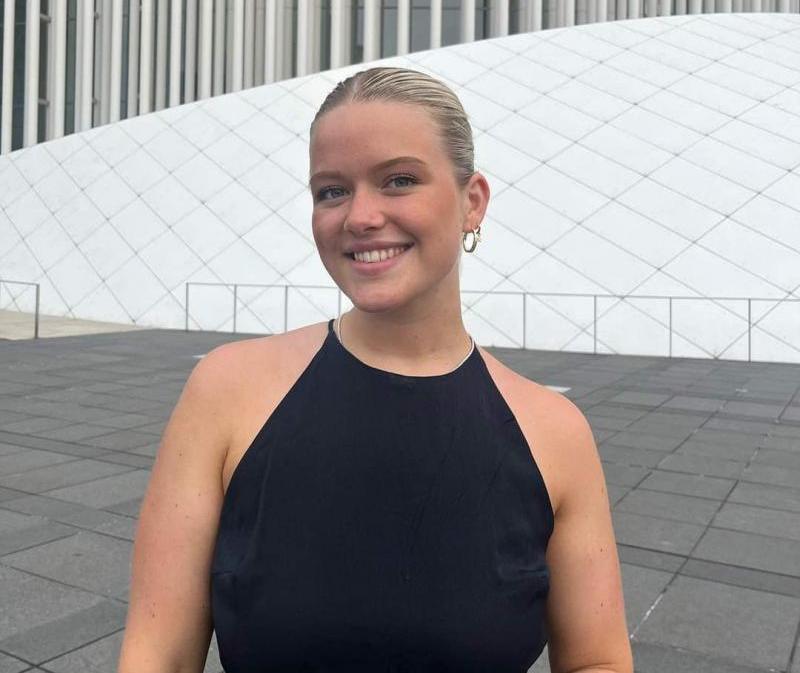
The BTS is sad to report the passing of Roger Groves. Roger was a member of the BBC Concert Orchestra and before that, the London Symphony Orchestra where he can be heard on the Star Wars soundtrack. We would like to pass on our thoughts to his wife Jilly, and to all that knew him.
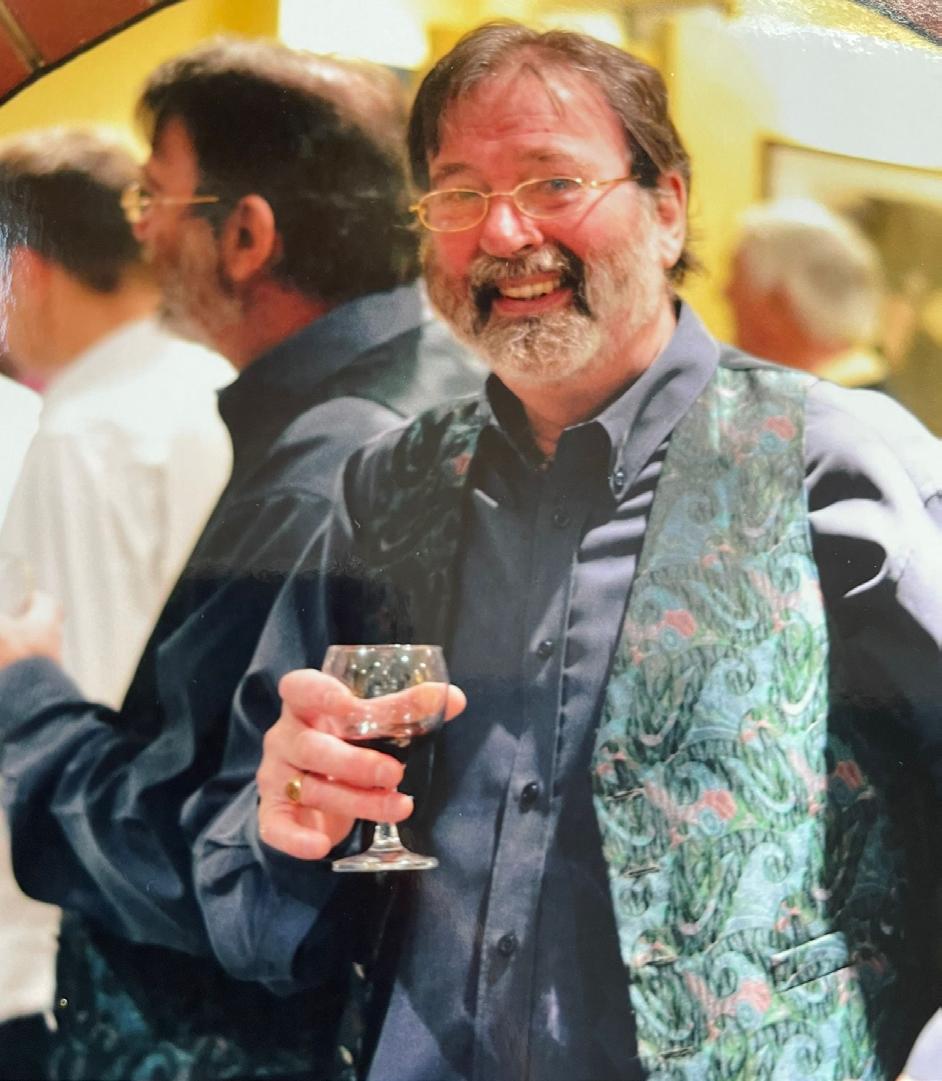
Roger's friend and colleague from the BBC Concert Orchestra, Andy Ross, has kindly written some words in Roger's memory.
'It was 1992 and the Concert Orchestra was embarking on an eight-week UK tour celebrating its 40th anniversary. We started the tour in Jersey and Rog was the first trialist, where it soon became known as 'Trial by Brewery'
Straight away the Orchestra fell in love with him. Rog was the obvious choice having come from the LSO as he was a fantastic and versatile player – the perfect 2nd trombone.
There are so many wonderful stories of Rog’s amazing wit. One for me was when we played a concert of Maurice Jarre’s music. Jarre had written a concerto for a very large bassoon-like instrument. As the conductor's downbeat was about to happen Rog announced, ‘He is going to play the Last Post’. The section just about managed to continue playing.
Rog was such a natural player, everything worked. His warm-up routine was to open the trombone case then get stuck into the daily crossword. His wife Jilly said he only practised when Scheherazade came up!
As part of their ongoing support of the BTS Sackbut Competition in association with Egger Instruments, members of the English Cornett and Sackbut Ensemble, Adrian France, Tom Lees and Emily White, organised a side-by-side coaching session which was offered to all of last year’s entrants. The session took place at Holy Sepulchre, London, the National Musicians’ Church, where ECSE are Ensemble-in-Residence, and was a great opportunity for young sackbut players to meet, play and socialise together!
It would have been his 80th birthday this November. So many happy memories of our time together at the Hipp and L’artista. RIP Rog.’

Inspired by her decade-long battle with Hodgkins Lymphoma, and being told repeatedly that she would not survive, Carol Jarvis’ new EP In My Veins celebrates being in remission for over ten years!

Visit Carol’s website to learn more about her story and download In My Veins. Click here to watch Christopher Bill interview Carol about this and other recent projects.
Huge congratulations go to the Hughes brothers for their category wins at this year's National Eisteddfod of Wales.
Bass trombonist George, about to start his final year at Chetham’s School of Music in Manchester, won Brass Solo 16-18yrs and tenor trombonist Freddie, a student at the Royal Northen College of Music, won Brass Solo 19yrs and over.
The BTS is incredibly proud to have supported both brothers though the BTS Instrument Loan Scheme.
The Barbirolli Society has released a recording of huge historical significance to the trombone world featuring Maisie Ringham giving the UK première of Paul Creston’s Fantasy for Trombone and Orchestra, Op. 42. Recorded for broadcast by the BBC on 10 May 1953, at Milton Hall Manchester, Maisie is accompanied by the Hallé, conducted by John Barbirolli. Purchase your copy here or here.
The première performance of Joe Chindamo’s Ligeia – Concerto for Trombone and Orchestra has been nominated for the 2022–2023 APRA/AMC Performance of the Year

Ligeia was commissioned by the Adelaide Symphony Orchestra for its Principal Trombone, Colin Prichard, who gave the first performances of the work with the orchestra at Adelaide Town Hall on 13 and 14 May 2022.
The work is to receive further performances in Melbourne with Jonathan Ramsay (Principal Trombone, Berlin Philharmonic) accompanied by the Melbourne Symphony Orchestra in April 2024 and will receive its European première in Ireland next season.
Click here to listen to Colin’s performance of this dramatic and exiting major new work.
Vienna Philharmonic Orchestra Principal Trombone
Enzo Turriziani has released his debut album, entitled Roots. Accompanied by the Band of the Italian Army, Roots traces the stages of Enzo’s artistic path to becoming the first Italian member of the VPO.
To coincide with the album release, the Getzen Company launched the 4047ET Custom Reserve, the result of a long collaboration with Enzo aiming to create the ideal sound he had always imagined.
On 14 July Blair Sinclair (Principal Trombone, Opera North) and Cillian Ó Ceallacháin (Principal Trombone, Scottish Opera) gave the première of a new version of Claire McCue’s In Pursuit scored for full orchestra, accompanied by the National Youth Orchestra of Scotland at Aberdeen Music Hall, with a repeat performance the following day at Perth Concert Hall.
The Edinburgh Music Review described the piece as ‘…a hugely theatrical work, exploiting not only the aural characteristics of the instrument…but also the visual physicality of the playing of a slide instrument in music that was not just scored, but choreographed.’ Click here to read the full review.
Beautiful Bones
This Summer sees two performances of Beautiful Bones, on 11 and 12 August as part of the Surge Festival in Glasgow and on 2 and 3 September as part of the Hull Freedom Festival. Described in 2018 by the Scotsman as ‘…an ebullient crowd-pleaser, pitting four skeletal horsemen of the apocalypse in chariots against a tribal trombone orchestra’, Beautiful Bones is designed as an inclusive community participation project that reframes the rituals of death as a celebration of life, featuring four professional trombonists drawn on chariots by wild performers (the horsemen of the apocalypse), a community trombone orchestra, and local brass bands. Read more about these performances in the forthcoming Winter 2023 edition of The Trombonist.

came out of the darkness at the back of Kingsway Hall, ‘Mute B sounds best!’. The version that Britten chose is still the one we make today.’
Britten's Best!
The winners of the quest for the Denis Wick #oldestmute may have been found stored at the company’s own factory in Poole!
Company Chairman, Stephen Wick, gave some background information.
‘These look like mutes from the very first production run in 1969. They have remained largely unchanged since then. The labels are different, and we use slightly thicker cork these days, but apart from that, they are the same.
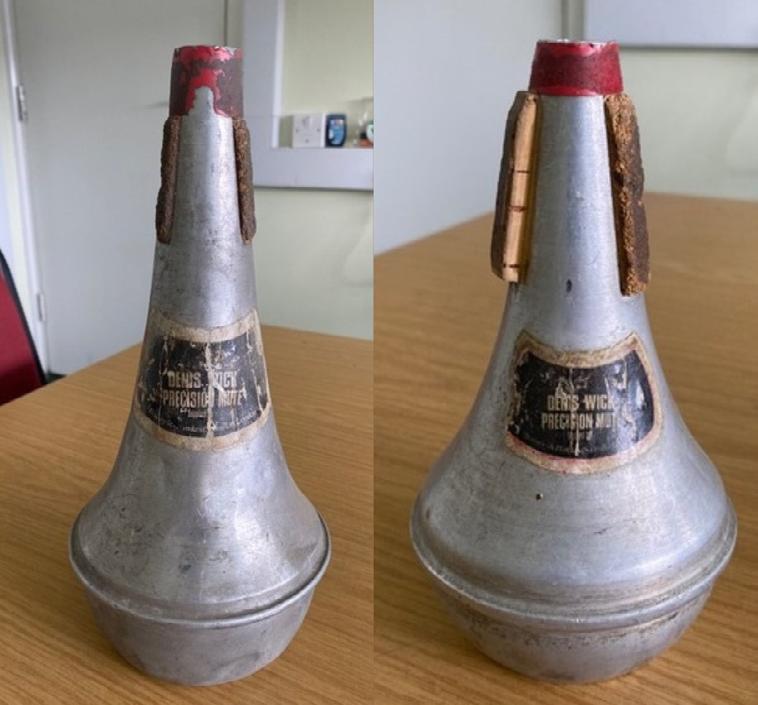
The trombone straight mute DW5005 has an interesting background. Denis wanted a mute which had a good sound, was in tune, and importantly, was easy to handle. It can be very noisy if you drop a mute in the middle of a quiet piece of music!
After extensive experiments he arrived at three good working prototypes. He took these into a recording session so that he could play them to his London Symphony Orchestra colleagues in the break between recording sessions. Unbeknownst to him Benjamin Britten (the LSO were recording some of Britten’s music at the time) heard the three different prototypes. A voice
Amos Miller, founding member of internationally acclaimed brass ensemble Onyx Brass and Principal Trombone with the Royal Ballet Sinfonia, will join the Royal College of Music as Head of Brass this autumn. An experienced educator, Amos has been Head of Brass at Royal Birmingham Conservatoire since 2018.

Amos has appeared as a guest with most of the UK’s major orchestras, as well as many international orchestras including the Chamber Orchestra of Europe and the St. Petersburg Philharmonic. His industry experience extends to the recording studio where he has performed on hundreds of film soundtracks including Paddington and Harry Potter.
Amos has led masterclasses all over the world, including at the Juilliard School, Beijing Central Conservatory of Music, and the Sibelius Academy, and in 2019 he received the BTS Teacher of the Year award. ◆
A fun day in Durham
Sunday, 30 April may have lacked the sunshine that has blessed previous BTS days in Durham and we could have wished for more players to attend, but what is certain is that those enthusiastic and doughty supporters who did join us, all had a really good day and the smiles on everyone’s faces told us one thing – everyone was having fun, which is really what BTS gatherings are all about.
We had assembled a varied range of guests and we knew we were in for a very entertaining afternoon.
Jon Stokes, BTS Vice-President had come directly from the Cheltenham Jazz Festival; Cillian Ó Ceallacháin, the Principal Trombone at Scottish Opera arrived from Glasgow and from Yorkshire we were very pleased to welcome the trombone section of the Brighouse & Rastrick Band, Ellena Newton, Charlotte Horsfield and Stephen Lomas. To support them, once again we had our distinguished accompanist David Murray, and we had also assembled, at Jon’s request, a jazz trio from local musicians, Ian Bosworth on guitar, Ron Smith on Bass and John Bradford on drums.
Our afternoon started with a massed blow which was, as ever, a rewarding experience. To see and hear a trombone choir made-up of a range of ages (preteenagers to decidedly third-agers!), with a range of experiences and backgrounds, all exploring some new music together and producing the wonderful sound that only trombones can, is always a highlight of BTS events. Jon Stokes led the session with his typical enthusiasm and a warm-up subtly based on two things – watch and listen. Forget about the dots, concentrate on the sound, and relax. What also actually happened in the warm-up was that John prepared us for the improvisation session that was to come at the very end of the afternoon.
We opened the mass blow proper with a piece receiving one of its earliest performances in the UK. As readers may know, the ITA celebrated its 50th
anniversary this year and it had organised a competition for a 50-second fanfare to celebrate this fact. The winning piece, called Fanfare for the World, was released via the ITA website in April. It is certainly an approachable composition, highly recommendable, and it proved very suitable for our sort of gathering. For fans of close harmony writing, we also played through a couple of arrangements of ballads, Love Walked In, arranged by Alec Gould and Carol Jarvis’ take on My Funny Valentine, both of which gave opportunity for some smooth playing and crunchy harmonies. To finish our first session, we played a splendid March, kindly sent our way by Brett Baker, called Spirit of Praise. Arranged for double trombone quartets, this went down very well and of course the contrast with the other pieces was part of the pleasure.
In fact, the massed blow had a sort of coda, in that Jon handed over the baton to Cillian, who took the ensemble through two short sections of the Overture to Verdi’s Nabucco, rehearsing them as he might do in his work in the Scottish Opera Orchestra. The overture has a prominent part for the trombone section and it
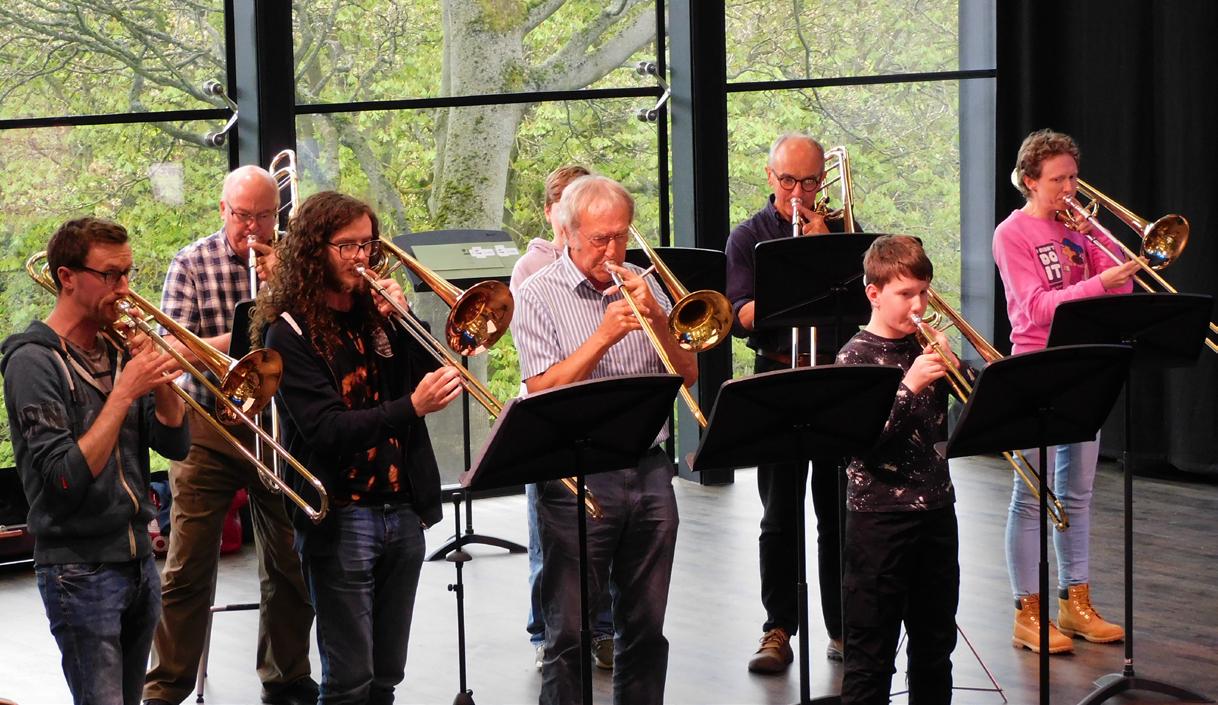
was certainly interesting and rewarding to examine how the music could be played. A short session, but an informative one, and of course everyone who was there now fully appreciates the importance of the phrase
‘I want a cup of tea …’
Cillian then progressed to his recital and once again his professional background in the operatic world was very evident. He opened with a formal piece for trombone, rarely heard perhaps but nonetheless attractive, the Aria and Polonaise by the prolific Belgian composer, Joseph Jongen, and he closed with a famous trombone piece, Thoughts of Love by Arthur Pryor. Both were splendidly played but, in a sense, his two
Tchaikovsky. With Cillian’s explanation of the contexts of these arias we had a very engaging experience and yet another demonstration of the versatility of the trombone.
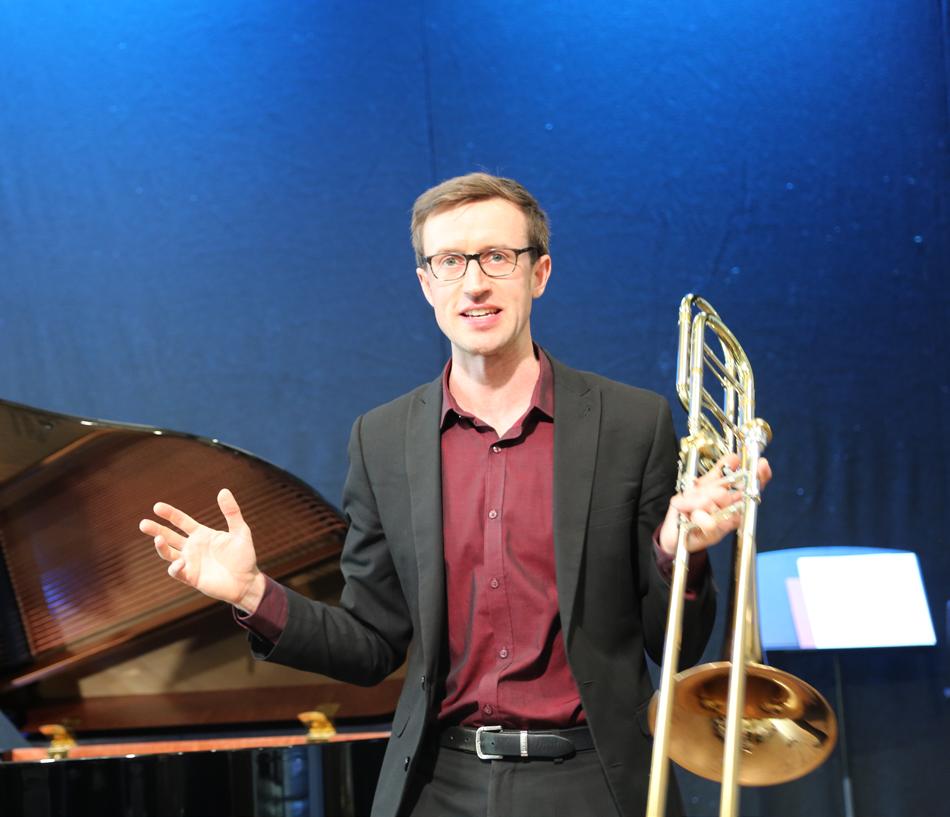

The Brighouse and Rastrick Brass Band is, of course, one of the most famous and successful bands in the country and at the centre of its success is its wonderful trombone section. Stephen has been our way before, but Ellena and Charlotte had to admit they had not been to a BTS event for some time but were nonetheless pleased to be with us. Each played a solo and they offered three trio pieces in which their warm tone and the perfection of their ensemble playing was just a joy to hear. They played Ray Premru’s Two Pieces for Three

other pieces were, for some listeners, just as, if not more, interesting. The trombone has always been noted for its vocal qualities, and as Cillian said, sitting in an opera pit, listening to vocal music, is what he does. So, he offered transcriptions of two operatic arias of contrasting moods, but displaying great emotional range. The first was the very moving Ach, ich Fuhl’s, from Mozart’s The Magic Flute, the second, a more heroic Kuda, Kuda, vi udalilis, from Eugene Onegin by
Trombones, a clever arrangement of a movement of a Haydn String Quartet, and a beautiful arrangement, by Phillip Wilby, which also involved the piano, of a Still Small Voice. As for solos, we were treated to three items from the top flight of the trombone repertoire: Stephen gave us a very funky Get a Move On by Rick Peperkamp, a piece which has an awful lot of black notes in it (!); Charlotte gave us a Robin Dewhurst’s Brasilia and Ellena gave us Pryor’s The Fantastic Polka. As a final treat, there was another slick trio arrangement of themes from Super Mario.
The main hall at the Mark Hillery Centre in Collingwood College is very suited to our needs, with the bonus of excellent supporting facilities, and the attentive presence of the centre manager, Michael Crilley, to whom we are grateful in helping the day to run smoothly. Ample rooms for pre-event practices, as well as an on-site café made for an easy flow through the day’s programme.
With Jon Stokes and his new friends Ian, Ron and John in the Jazz trio, we were treated to a wonderful set of numbers, all demonstrating why Jon is so highly-rated in the jazz field. Opening with a stunning
PHOTO CREDIT: LYNN THORNBER CILLIAN Ó CEALLACHÁIN. PHOTO CREDIT: GEOFF WOLMARK L-R STEPHEN LOMAS, CHARLOTTE HORSFIELD, ELLENA NEWTON.rendition of Sweet Georgia Brown, he proceeded through a range of different moods, with numbers such as All of Me, Embraceable You, In a Mellow Tone, Happy Feet Blues, Do You Know What It Means to Miss New Orleans? (a piece he played a lot in the open air during Covid!) before finishing with a rip-roaring classic, Bourbon St. Parade. Apart from the wonderful improvisation and huge variety of sounds Jon produced for us, one of the pleasures was the trio’s own solos and it was very clear that in the short time Jon and the trio worked together, they all had a great time, sparking off each other’s playing. It seemed they could have gone on for hours.
Sadly, all good things had to be drawn to a close, although we did have one final treat. A very select, but encouraging audience, was present for our final run through of the massed blow pieces and then just as we might have been packing our trombones away, a final chart was produced. Remembering our warm-up notes, Jon gave us all parts for Mo’ Blues, including some meaty bits for the bass trombones, and with a nod to
the rhythm section, we were off – everyone, even those who said they could not improvise, playing along in a massed group, with optional solos, in all sorts of octaves, but making one big happy sound. As we said at the start ‘What Fun!’ and the thanks and good wishes at the end from participants, guests, and us to them all, added up to another successful Durham day. ◆
Peter Chester & David Thornber are joint BTS North East Representatives:
 JON AND THE JAZZ TRIO. PHOTO CREDIT: LYNN THORNBER
JON AND THE JAZZ TRIO. PHOTO CREDIT: LYNN THORNBER
I do appreciate you lovely lot writing in, in relation to this page of the magazine. It gives me an opportunity to either find some solutions or to think a bit more on various subjects. One of our members, Phil Hawker, has sent in a couple of questions.
Do you have any experience of hand-rests?
In recent years, I have noticed a drive for all musicians to take a bit more care of their bodies and to understand how the body copes with extended periods of playing or the weight of an instrument. I have seen many players use a variety of hand-rests and harnesses – some for prevention from injury, some for recovering from an injury. There are a variety of aids out there; hand braces from Rath and Hagmann, Neotech fabric grips or the more simple Sheridan Get a Grip and CalderPips Grips to name but a few. Another aid is the ErgoBone which is an incredible set up that has got some of my colleagues back playing much sooner after suffering physical problems than they would have done without.
I have personal experience with using the Rath and Hagmann but now only use the Hagmann rest on my Contrabass Trombone. The large pad for the back of the hand is extremely comfortable.
Playing a brass instrument is very physical and holding a large piece of metal with one contracted arm, whilst keeping the dexterity in the left hand for valve work, and the slide arm needing to not carry weight to allow for complete control, can create all number of issues. We should all be doing some sort of basic strength work, stretching and keeping our bodies in the best health we can. Listen to our bodies, be proactive when pain occurs and be smart about your playing.
I will touch on free buzzing, buzzing on the mouthpiece and also on some other practice tools. Free buzzing can be a great way to get blood into the lips at the start of a practice session, also a simple way to relax the lips after a strenuous concert. I don't advocate an immense amount of free buzzing as I do not think it's quite the same as when we are in contact with the mouthpiece. The lack of resistance and anchor points for the embouchure may create more problems. Buzzing on the mouthpiece is a useful tool but I do this with a pitch reference – cello drones (found on YouTube or Spotify), a piano or similar. I will also buzz with the mouthpiece and lead pipe. This gives me a sensation much closer to that of playing the trombone and can also help me to really centre the pitch when I transfer over to the trombone – I use this as a practice tool too, not just for warming up. Any exercises you can do on the trombone you can copy with buzzing, although take care; little and often will be more beneficial.
Of course, playing the trombone is personal and individual and some things will work worth others and not for some. If you would like to comment on anything I have said or want to unpick more, do drop me a line at president@britishtrombonesociety.org.
I look forward to hearing from you all soon.
As ever, please do email in anything you would like me to address or babble on about to president@britishtrombonesociety.org or find me on Instagram @th_minsh ◆
We are delighted to welcome a new instrument into the BTS Instrument Loan Scheme. Huge thanks and gratitude go to Martin Voigt at Jurgen Voigt Brass for generously donating a beautiful bass trombone. The model J-164 is an independent set up with a gold brass bell and features an adjustable hand rest and an ergonomic slide cross stay for greater comfort. This instrument will be added to our existing collection, bringing the total number to six, to be used by a younger player in need of a quality instrument.

Aiming to encourage the youngest generation of trombonists and to build on the success of recent events, such as the British Trombone Festival 2022 Youth Day and the South West Trombone Day 2023 hosted by Wells Cathedral School, the Society has introduced a new junior membership subscription category for under 16’s.
The BTS has partnered with Slide Action to support the production of a series of videos entitled 'Slide Action's Trombone Toolkit'. Intended as a resource for composers looking for answers about just what the trombone can (and can’t) do, it is hoped these videos will be interesting and a great educational tool for all musicians.
Each year the BTS Instrument Loan Scheme and BTS Bursaries support numerous members across the country. Below we hear from some of the 2022 recipients about how their awards have assisted them over the last year.
The BTS loan scheme has benefited me greatly during my first year of studying music at Oxford University. I have played the Rath R400 in multiple recitals (including my final first year performance exam) and it has been an amazing experience getting to use a professional instrument. I have found that it has really aided the improvement of my sound and my teacher has helped me develop my technique using it. It has also been useful in the ensembles I am a part of, particularly whilst playing new music that calls for advanced techniques. For example, I worked with composer Simon SteenAndersen whilst playing his work Chambered Music,
NEW LOAN INSTRUMENT. L-R KIRSTEN VOIGT, SIMON MINSHALL, MARTIN VOIGT.and the trigger attachment allowed me to convey the sound he was aiming for in a way that wouldn’t have been possible otherwise. Both my teacher at the Royal Birmingham Conservatoire and my tutors at university have noted my progress during the year, particularly regarding sound quality, and the loan scheme is largely to thank for that. I have been extremely grateful for this opportunity offered by the BTS.
instrumental in helping me to achieve my musical ambitions. Thank you so much!
Receiving a loan instrument from the BTS has been an incredible experience that has allowed me to progress in my playing on a high-quality instrument, at a time when my financial situation wouldn’t otherwise have allowed this while studying for my degree. The instrument has been invaluable in being able to further develop my technique and repertoire and knowing that the instrument was donated in memory of Tony Parsons, with his signature engraved into the counterweight, provided an extra boost of inspiration in each practice session. Over the course of the last year the instrument allowed me to develop my technique, learn more repertoire, take part in some great performances and development opportunities, and achieve my ALCM diploma, with practice underway to sit my LLCM later this year. Thank you BTS for the opportunity, it’s been invaluable over the last year.
Diss Located Bones is open to all East Anglian trombonists. When Tony Parsons and Andy Gray were running DLB, the rehearsals were in Diss, Norfolk, and the name ‘Diss Located Bones’ was very funny: we now rehearse in Haughley, Suffolk.
I’d like to say that the loan of the Conn trombone has helped me enormously. What a wonderful instrument! It's allowed me to do everything I need to do on the trombone. It has a great sound, with the wide bore bell. It also has the valve which allows me to do short cuts and achieve complex rhythms that my jazz band members were amazed by when I first started doing them!
The slide was a massive step up from my previous trombone (it was very rough) as it’s extremely smooth, improving my playing significantly – it’s helped me to play faster passages much more easily. The deep sound has been amazing for playing in a quite loud ensemble (I am one of only two trombones); it’s much louder and given me a greater diversity of tone compared to my previous trombone.
The experience has given me an insight into the range of sound and styles a trombone can produce. I had no idea about this beforehand! I wasn’t expecting the quality and I'm so pleased I had the good fortune to experience it.
I’m extremely grateful for all the help and generosity of the BTS, including the bursary award which will go towards my next trombone – you have been

Last year we were awarded a BTS bursary, which covered our hall hire for the year. We were very grateful for this, as it was paid directly into our Parish Council account and we didn’t then have to think about collecting subs, which can be awkward if you have an open group and don’t know how many will turn up. But, more than that, we felt supported by the BTS community. We are also hugely grateful to the BTS for being able to access their library of music.
The photo shows Dave Charles, Tom Yates, Paul Beer and myself representing DLB at a charity event in Felixstowe this Summer (you don’t often see two Elkhart 62h bass trombones on the same stage!). It was raining heavily when we arrived, but the sun came out just as we got on stage. We were well fed and watered, and a good time was had by all.
 Luke Hoban
LUKE HOBAN. PHOTO CREDIT: TOM HURLEY
Luke Hoban
LUKE HOBAN. PHOTO CREDIT: TOM HURLEY
This summer the National Youth Brass Band of Great Britian welcomed Scott Hartman to tutor the trombone section during their summer course and perform as featured soloist at their Summer Concert. A world-renowned soloist and chamber musician, Scott was a member of Empire Brass Quintet, a founder member of trombone quartet Four of a Kind and is Principal Trombone of the Brass Band of Battle Creek and Professor of Trombone at Yale University. Scott’s wife Sarah Ioannides was Guest Conductor for the course, making the visit a family affair.
Three NYBB members, Principal Trombone Adam Warburton, second Second Trombone Jennifer Ewington and Principal Bass Trombone Malachy Cullen sat down with Scott in a break from rehearsals to find out more about his life and career.
Adam: Have you ever visited the UK before?
Scott Hartman: I have been, not enough really, but over the years I’ve been here a number of times. My wife grew up in England, so we’ve had a chance to come back to visit family recently.
The first time I came to England was when I played in the Empire Brass, probably about 1985, 1986. We did several tours over here and we toured around the country, which was really fun. It’s one nice thing about what I have done in my career is play chamber music a lot and chamber musicians get to travel around, a lot like the brass bands get to travel. And so for me, that’s really fun. The more I travel, the more I realised there are so many places to go. But I’m familiar with England anyway.
M: You talk about chamber groups? What steered you towards doing chamber music over orchestral work?
SH: Well, I went to Eastman School of Music, which is sort of a conservatory, separate from my university [University of Rochester]. I wanted to be a jazz trombone player, but when I got to school it became really clear that there were a lot of people who were further along with their jazz playing than I was, and I got a little afraid of succeeding and so I sort of figured that I was actually maybe better on the classical side, the orchestral side, than my jazz talent seemed to warrant and so I focused on that. When I got out of school, I was hoping to get an orchestra job, but it turns out that I got a job with a brass quintet, Empire Brass Quintet. I had an audition, got that position, and ended up really liking that lifestyle, and so I pursued that. I do like playing in orchestra, but mostly get to do chamber music.
Jennifer: How did the opportunity arise to perform with and tutor NYBB?
SH: Well, I think it was typical to almost everything that’s happened in my career and many musicians’ careers. The network of colleagues and friends that are aware of me and have worked with me and had made some recommendations. I know Stephen Mead recommended my wife as the conductor, I’m not sure how I became part of the package deal, really! Luckily, I do play in a brass band back in America, the Brass Band of Battle Creek, which is sort of a seasonal band. We only really get to play together two weeks out of the year these days, but people come from all over. Four, five, six people come regularly from the UK, brass banders, really outstanding people, I won’t name all the
names because I don’t want to leave somebody out. I expect that somebody, they’re aware of me through the brass band or through my other things, and so I was asked, and I said ‘Yes, thank you!’
A: You mentioned the Brass Band of Battle Creek. How do you find playing in a brass band compared to a chamber ensemble?
SH: Ah well, it’s nice to sit in a section, you know? I like chamber music because I get to play in a small ensemble without a conductor and you’re very responsible to make music and decisions for yourself in the chamber ensemble. But you know, as nice as a brass quintet is, a brass band is like seven times a brass quintet as far as the sound [goes], the amazing brass band sound.
I’ve always loved that sound and when I had the opportunity to play with the Brass Band of Battle Creek I took that opportunity, which is another topic we might talk about. When you get an opportunity, think twice, three times before turning it down because sometimes you don’t get that chance again. I was very fortunate to be asked to play and I really enjoy working with really amazing players, and the attitude is very similar to the attitude that I notice here in brass bands in the UK, very collegial, very family oriented and it’s about making music as a team and just enjoying the process. That’s what Brass Band of Battle Creek is like as well, which is not necessarily what you find in every
orchestra. Sometimes it turns into more of a job, but this is more of a special occasion. You know, a special vacation that we get to go play, make music together.
J: You mentioned how you can see similar attitudes between the Brass Band of Battle Creek and here. How does the brass band scene, which obviously has quite a lot of history here in the UK, compare to the US?
SH: Well, we don’t have that continuous history that you have. I know the brass band tradition has been challenged somewhat by the loss of sponsorship by organisations and towns, but even more so in the States. 100 years ago, we had a tradition of town bands and company bands, but we seem to have lost that unfortunately. So that’s a major difference, that you folks have this infrastructure that there’s a local band close by and you get to hear those bands from the point when you’re young and sort of hear the sound and understand what you’re shooting for. Whereas in America, we don’t necessarily know what a brass ensemble sounds like when you’re 10 years old. Many of the students don’t know what a trombone is, don’t know what a tuba is, they haven’t really heard them and they, you know, they think they’re saxophones. So that’s an unfortunate thing that we’re fighting against in the States. We’re trying to broaden the awareness, you know, to get people to be aware, because they love it, everybody that hears a brass
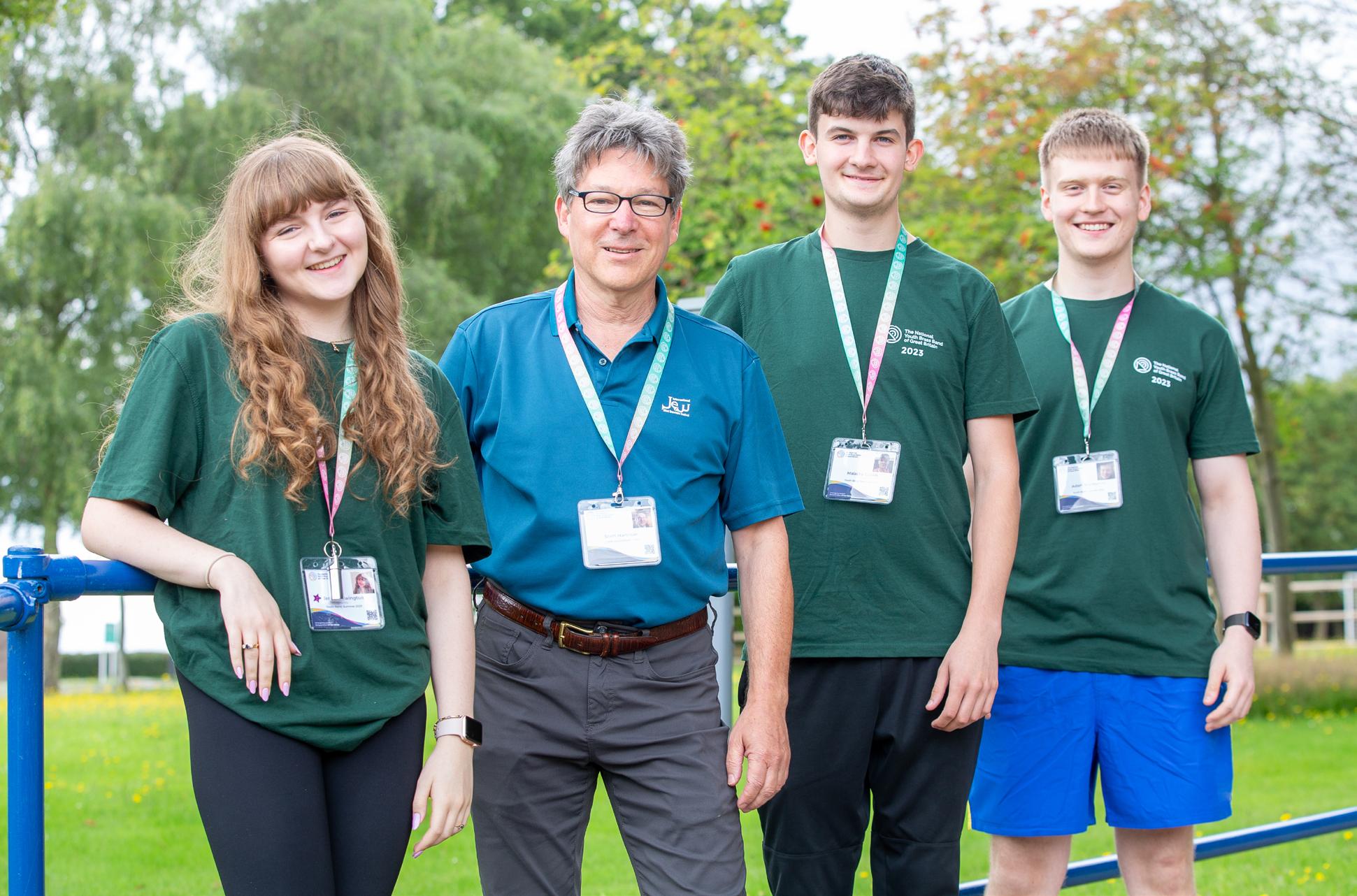
band, loves a brass band. So, it’s just a matter of being exposed.
M: You talked about your university time, but how did you come to start playing the trombone?
SH: Back when I was around 10 years old, that was the traditional time that we could start music in our school band. And back then, almost throughout the country, the school band programme was really strong, so it was very prominent, everybody understood and heard that music played by their friends. My older sister played clarinet in the band, so when it was my turn to be able to play in the band it was just a natural thing for me to do. My family’s musical, I had a lot of music in the family beforehand and it just seemed to be a natural course. I didn’t really have a strong opinion about what I played. I figured a brass instrument, that was my preference, anything, give me anything and my dad said, ‘Well, why don’t you play trombone?’, and so I did and so I’ve stuck with it really, somehow, I’m just a trombone player.
A: You mentioned that your family is quite musical, were they your main influences or did you aspire and look up to anyone else?
SH: Yes, they were my main influence early on. We didn’t have a record player when I started, I don’t think. My uncle, he made music, he was a musician and teacher his whole life. And my dad, he did it part time up until middle age, he’d stopped being a professional musician at that point, but my mom took lessons from my uncle, so it was just already intertwined with music from that point. I drew a lot of inspiration [from them] and they encouraged all the kids. They would ask us to pull out our instruments and play for them. I mean, what are you working on? What solos do you have? What songs can you play? So that was really nice. And then when I started to play my influences were mostly through recordings, you would see things on television as well, but Tommy Dorsey, Jack Teagarden, the era of the swing bands. That’s the age my parents, my dad, grew up in, and of course that’s a heyday of brass playing and live music, so I grew up with the recordings. And Urbie Green, most of my early influences were jazz trombonists. And then later, actually there weren’t a lot of classical recordings done, not available anyway to me when I was your age, but then it became through CD’s, you know? I was about your age when CD started to come out and that fostered a big boom, people like Christian Lindberg and Joe Alessi and Alain Trudel, Michel Becquet, Branimir Slokar. That generation of trombonists were becoming the soloists whereas in the generation before that, there really weren’t too many, and so it just blossomed at that point.
J: You’ve mentioned all these recordings that influenced you, especially earlier in your trombone playing journey. How do you think those individuals and their style influenced your personal style of playing?
SH: I’m very aware of their influence even now. I think Tommy Dorsey was my number one influence. You’ve heard him hopefully, with some recordings from that period, just a beautiful lyrical player. Very, very pure sound, beautiful vibrato and that was for me, that was what a trombone did. And so, I still love playing melodies and singing songs on the trombone. My other primary influence at that point was Jack Teagarden; he was a contemporary of Tommy Dorsey, a fantastic Dixieland era jazz player and a real virtuoso and just, you know, this spontaneous sort of exuberance and joy that he brought to his music, and rhythm: what really inspired me and what I really enjoy is rhythm and I think that he tapped that nerve for me.
M: How did you manage to perfect the tone that you wanted?
SH: Oh well, that’s a long process. The simple answer, which I think maybe is the best answer, is I just had the sound in my ear. If you’ve got the sound you want to make in your ear, then you will keep moving towards it, and then you’ll get closer and closer and closer and you’ll realise, ah, there’s a lot of different sounds. There’s a perfect sound for every occasion I guess, and you get to decide [in] that moment what sound you want. So I think really just trying to make the sounds that I had in my head led me in that direction. If you want to talk trombone technique for a second, then I think the thing that allowed me to do that even more, to help move in that direction successfully, is I started to learn how to buzz mouthpiece and buzz without a mouthpiece. It helped me to get control of the mechanism that actually makes the sound for us, which is our aperture.
A: Speaking about buzzing and mouthpieces, what instrument and mouthpiece do you use? How does that help you reach that tone you’ve got in your mind? SH: OK, good. Good. I like that question. I would say that the instrument you play contributes to the sound, your generic sound, your footprints, DNA, whatever makes you unique as a player. Think about, say, Louis Armstrong. I wouldn’t say that he necessarily started out on the most efficient equipment, but he made it work, and that’s what musicians do, whatever you hand them, they’ll make it work somehow. But then sometimes the equipment can sort of box you in and maybe articulations might not be so good or the range, you might chip notes because of the instrument not
necessarily being as accurate or efficient as it could be. I’m always intrigued with different horns, I’m playing a Shires this week, I’ve been playing a Shires as my primary trombone for quite a while, but I do really appreciate all other instruments and they’re slightly different and so I like the unique characteristics of all the instruments. I see some Raths here, I see some Bachs, I don’t know if there was a Thein, I don’t think there was a Thein, but you know Bach and Edwards, they all make really nice instruments. But then you mentioned mouthpieces, I actually make mouthpieces. I started to do that just so that I could figure out how to get a mouthpiece that would respond to what my embouchure put into it without being twisted around and distorted and having to work around the mouthpiece. So I play my own mouthpieces, and I try to fit them to the horn, so that what I put into the horn is translated as efficiently as possible, and that’s a lifelong quest for all of us brass players.
J: You said you used your own mouthpiece. What did that process look like developing that, finding what works for you and what you thought was, as you said, most efficient.
SH: So, it’s been a long process, frustrating process. I started buzzing like I said, and the idea was just to help my embouchure get stronger and be able to buzz, primarily higher, and not miss as many notes, and that started to work and I got so that I could actually buzz higher and lower with more accuracy, and better intonation, than I could on my instrument. Then I tried it on the mouthpiece and it is, you know, harder, and the mouthpiece was harder with the mouthpiece in the trombone. So that seemed to indicate that the equipment was not quite as helpful as it should have been and so then I started first working on equipment at the same time as mouthpieces but going to people who make them. I went to John and Phyllis Stork, who helped me a lot. We [would] work on a mouthpiece and then I’d take it home, work on it, trying to get used to it and I’d bring it back and I’d keep bringing it back and then eventually I just didn’t want to bother them anymore. I said, ‘I think I’m going to get my own lathe and try to figure this out myself’, and John said, ‘You know what? You’re going to be sorry about that sometimes.’ And he was right, I’ve been sorry about it, lots of times. But you know, I became sort of obsessed with trying to sort this out, so first step was trying to figure out how to get the embouchure to speak clearly, like what you put into it, so I figured that out by adjusting the different dimensions and parameters of the mouthpiece. It’s a long story but I did figure out how to balance the mouthpiece, so the mouthpiece was more neutral and acoustically correct. I noticed that a ‘good
mouthpiece’ is, I think, one that speaks properly, and then it can have other characteristics, but as long as it speaks properly, I’d say it’s good. But a good mouthpiece doesn’t necessarily match every horn, so every horn would benefit from having a mouthpiece that’s mated it to it. And then the characteristics of the trombone are revealed that way. You can play higher, you can play lower, you can play slurs, you get the sound of the trombone, and then if you don’t like that, you have to start working on your trombone. So, it’s a never-ending process but I’ve made progress, which is encouraging.
A: Are your mouthpieces available to the public to buy?
SH: Finally, yeah, finally they are. I’ve got a website where you can see some of the unique things, how I think about them.
J: You’ve had a very, very successful and varied career, but what motivates you to keep on getting better and keep on improving and carry on performing?
SH: Yeah, you have to wonder don’t you, do I really wanna do this again today? But like I said earlier, I’m just a trombone player. I love to play the trombone and it’s really fun to make music, which you all appreciate here, and so that’s why we do it. Nobody’s forcing us to do it right. I still want to get better, I want to try to, I like the process of playing the trombone and trying to get better, but I also just like making music with people, the social aspect is really nice. I still teach and I get to talk to people who love to do what I like to do; I’ve been doing it for a long time and I can give them some pointers, so I look forward to my teaching as well as the playing. It’s a lifestyle.◆
 SCOTT AND SARAH IN ACTION WITH THE NYBBGB.
SCOTT AND SARAH IN ACTION WITH THE NYBBGB.
The results of the 2023 BTS Composers’ Competition were announced on 14 August. The judging panel of Mark Nightingale, Callum Au and Benjamin Ellin awarded First Place to Ian Schwalbe for Go Where You Please. Runners-up prizes were awarded to Brady Johnson for Octet Number 1 and Noah Killough for Eli Eli. All three prize winners are young American composers. Salvatore Sciaratta was highly commended, continuing his record of success from the 2021 and 2022 editions of the competition. Go Where You Please will be published by Warwick Music.

Ian is an up-and-coming composer and trombonist from Alpharetta, Georgia. He is currently studying composition with John Fitz Rogers and Fang Man, and trombone with Michael Wilkinson at the University of South Carolina. He is a member of the USC Wind Ensemble and Symphony Orchestra, and has also been a member of the Carolina Crown Drum and Bugle Corps. He has recently performed at the Brass Institutes of America festival in Wichita, Kansas, and with the South Carolina Brass Band.

Brady, aged 17, currently attends North Oldham High School in Goshen, Kentucky. He began composing music early in junior high and since then the majority of his spare time has been dedicated to writing scores. Some of his most recent projects have been creating scores for short films, as well as participating in competitions, creating full orchestral pieces.

Noah is a 17-year-old senior at West Plains High School, Amarillo, Texas, and plays tenor trombone for his High School as well as participating in local trombone choirs and some orchestras. He is a young Christian Classical composer, and has composed and arranged for some local groups, including a local colleges’ youth trombone organization known as the Buffalo Bone Initiative. This year Noah was selected to participate in the Texas 5A All State Band and was also the recipient of a John Philip Sousa award.
For full biographies of this year’s winners please visit the BTS website
The release of Windows in July marked the culmination of Christian Jones and Benjamin Ellin’s ambitious project, charted through the pages of The Trombonist, to commit Ben’s trombone concerti to record. A detailed account of the recording sessions can be found in the Spring 2023 edition of this magazine, along with Peter Chester’s impressions of each work.
Listening to the finished album I was struck not only by the (expected) world class performances of the soloists and the excellence of the Orchestra of Opera North, but also by the sheer quality and musical integrity of the works recorded.
Both Pandora, written for and performed by Joseph Alessi, and Gresley, written for and performed by Christian, intentionally eschew virtuosity for virtuosity’s sake, in favour of exploring musical argument and the relationship between soloist and orchestra. Ben worked closely with both performers to understand what they wanted to express as soloists, so as he wryly points out to future performers in the album booklet ‘any technical challenges presented in the music…were the very challenges our soloists wanted to embrace’.
For the two trio works on the album Joe and Christian are joined by Opera North Principal Blair Sinclair. ‘Stow Sketches, composed as a standalone trio for the Opera North section, gives an opportunity to enjoy the very distinct voice of each performer in the purest way: in Ben’s words ‘a palette cleanser between the concerti.’
Windows for trombone trio and orchestra was commissioned especially for the players on this recording and as Ben writes ‘is designed to give little glimpses of some of the themes/characteristics of

the trombone section: chorales, jazz and funk and improvisation to name a few.’ In seven short minutes, packed full of excitement and virtuosity, Ben has created what deserves to become a go-to showcase for the orchestral trombone section, hugely satisfying for performers and audience alike. The BTS is proud to have supported the commissioning of this major new work as part of the Society’s ongoing commitment to encourage new, high quality, compositions for our instrument.
In addition to all the performers involved with this project special praise must be given to producer Mike Purton and recording engineer Ben Connellan; the clarity and detail achieved in this recording, without any loss of warmth or richness, is exemplary and contributes greatly to its success.
This album is a singular achievement on so many levels – I know of no other recording featuring one composer’s tenor and bass trombone concerti and a work for trombone trio (itself a miniature concerto), all accompanied by full orchestra – but ultimately it represents the legacy of a friendship born through music.
If you buy one album of trombone music this year, make it this one, you will not be disappointed.
Windows is available to purchase here, or can be streamed via your favourite streaming service: the booklet accompanying the album can be viewed here.
To celebrate the release of Windows we have a copy of the album, signed by Christian, Blair and Benjamin to give away to one lucky reader. Simply email editor@ britishtrombonesociety.org to be entered into the draw. Entries close on 28 September. ◆
25 May saw the official launch of Kris Garfitt’s debut album Kaleidoscope at the Royal Over-Seas League, London, the venue where Kris had won the Gold Medal in the 2019 ROSL Music Competition, a prize which he informed the audience had funded the production of album.
Kris presented five works from Kaleidoscope: Ropartz’s Pièce in Eb Minor, Crespo’s Improvisation No. 1, Weber’s Romance, Krenek’s Five Pieces for Trombone and Piano, and Guilmant’s Morceau Symphonique. The remaining two pieces on the album, Martin’s Ballade and Handel’s Trio Sonata in G minor, were not given.
By his own admission Kris is drawn to the Romantic trombone repertoire and both the Weber and Guilmant were given thoughtful and authoritative performances. It is noticeable, both live and on record, that his tone develops a distinct intensity when performing this music and possesses the ability to get inside the sound of the piano to such an extent that at times the distinction between the two instruments disappears, an effect put to magical use during the final chord of the Romance. In contrast, Crespo’s unaccompanied Improvisation No. 1 was dispatched with virtuosic brilliance, the soloist maintaining a level of spontaneity and freedom that perfectly matched the extemporary nature of the work.
As Eric Crees writes in his excellent programme notes to the album, Krenek’s Five Pieces ‘shock, bewilder, momentarily soothe but always surprise the listener’, employing, as they do, extended techniques for both trombonist and pianist. The audience was delighted by the theatre of what was for most an unfamiliar
piece, and it was very pleasing to see the performers obviously enjoying themselves. Listening to the recording of Five Pieces is a different experience, shorn as it is of the visual component, but it does again highlight Kris’ fine ear for tone colour, which makes his manner of performance so satisfying.
The recital ended with a Suite of pieces by Ervin Schulhoff, recently arranged for Kris. Born in 1894, the Austro-Czech Schulhoff was one of the first generation of classical composers to find inspiration in jazz music, but also one of a generation of musicians whose successful careers were prematurely terminated by the rise of the Nazi regime in Germany, who labelled him and his work as degenerate because of his Jewish heritage and radical political views. He was imprisoned in 1941 and died of TB in 1942, whilst still incarcerated. A composer whose works are only now being rediscovered, I very much hope this Suite will in time be published, as it is a highly evocative of the cabaret music of inter-war Central Europe; Kris said he imagines himself accompanying a silent movie when playing these pieces.
Special mention must be given to Seri Dan, an extraordinarily sensitive and supportive accompanist and Kris’ long term duo partner. Their almost telepathic relationship when performing together is a mark of truly great chamber musicians.
Kaleidoscope is available for purchase from Willowhayne Records. To learn more about Kris visit his website.◆


The second instalment delving into Warwick Music’s catalogue of newly published works features compositions from Rob Wiffin, Benjamin Ellin and Mark Nightingale.
Don’t forget BTS members receive a 10% discount on direct purchases from the Warwick Music website!
Rob Wiffin’s three movement Sonatina for trombone and piano sees the composer return to a more substantial work after creating several lighter pieces. Influenced by a move, in early 2021, to live in Lancing, each movement reflects the composer’s fascination with the endlessly changing sea.
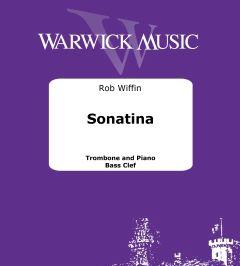
The first movement, The Cry of the Gulls, in which hints of the bird’s mews are heard in the piano part, is a lilting 6/8 movement, the contours of the melody clearly following the gulls’ movements as they soar above the sea and swoop down to the land. Two endings are given for the movement, one for stand-alone performance, the other for continuation to the second movement, Sea Mist. Sea Mist depicts ‘the ambiguity of the winter sea with focus softened by the mist that gathered and clung to the coast...’. A simple motif is continually developed, as if distorted by the swirling mists, returning periodically as the mists clear before being obscured once again. Sea Spray, the final movement, is the most technically demanding both in range, pedal A to high Db, and dexterity, with fast arpeggio figures and large jumps in and out of the pedal register.
Sonatina is a great addition to the repertoire: accessible to both performer and listener, the evocative characterisations found within will bring contrast to any recital, though I suspect The Cry of the Gulls will become popular as a stand-alone piece.
Before Gresley came Benjamin Ellin’s Vantage for bass trombone and piano. Commissioned in 2018 by Christian Jones, Vantage ‘explores the journey a note
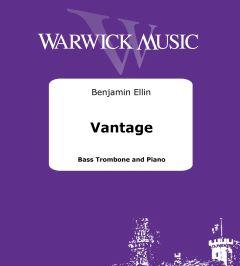
can go on within the harmony of a piece or a melodic line.’ The work opens with a slow section, freely tonal though predominantly minor, marked Distant and Mysterious, the ever-evolving melody giving the soloist ample opportunity to showcase the dark timbre of the bass trombone against a relatively sparse accompaniment. The second section, Allegro brilliante, requires greater dexterity from the soloist and features more rhythmic interplay with the piano. Overall range is from pedal Eb to F above middle C and whether by chance or design, there are no low B’s, allowing performance on a single valve instrument. Posing musical rather than extreme technical challenges, Vantage will be accessible to most bass trombonists and should be a serious consideration for any recital.
Click here to listen to Christian performing Vantage Mark Nightingale’s 27 Mega Duets builds on his extensive and hugely popular body of work published by Warwick Music, by expanding and adding duet parts to some of his favourite studies, drawn mainly from Tricky But Tempting and Jazz@Etudes. The upper parts range from an intermediate to an advanced level, with several ascending to high D, whilst the lower parts are mainly advanced, requiring great facility within the clef. Although conceived for two equal instruments, the lower part is in the main playable on bass trombone, with the opportunity for some octave transposition practise from time to time.
27 Mega Duets covers every style imaginable: from a parody of Greensleeves to 20th Century Impressionism, via swing, Latin, and several marches, all underpinned with Mark’s trademark sense of humour. Many of the duets focus on a particular aspect of technique, suggested by titles such as Carp-eggio, Shiftissimo and Staccromtaic; challenging but huge fun to play, especially in good company. ◆
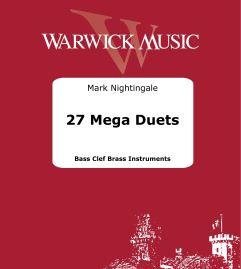
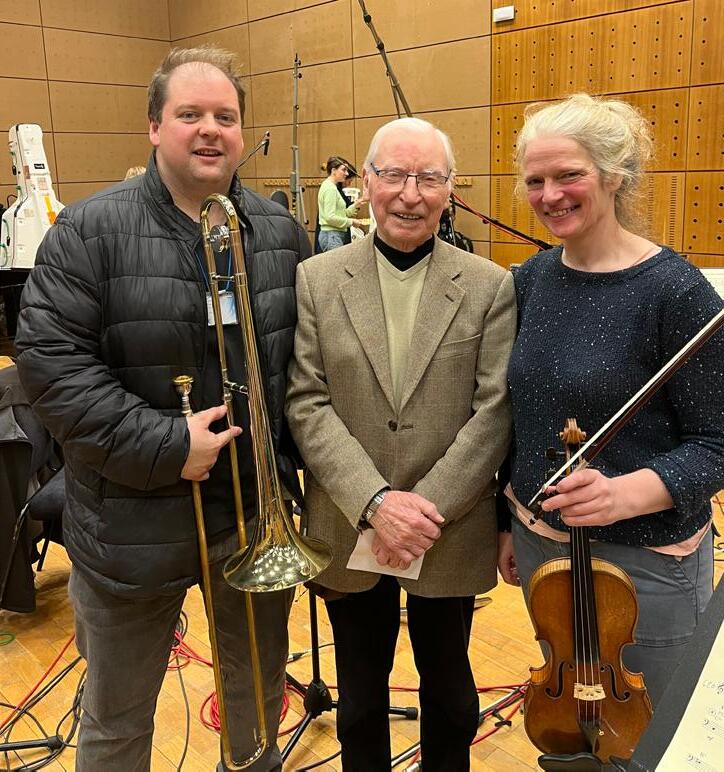

 BY ALASTAIR WARREN
BY ALASTAIR WARREN
The main BTS contribution to ITW 2023 was a collaborative video recording project, open to players across the UK and beyond, featuring an arrangement of Henry Purcell’s Rondeau for 10 trombones and drum kit, specially created for the occasion by BTS South Representative Michael Pilley. Huge thanks go to Michael for co-ordinating this project and producing such a fantastic video.
Rondeau has been added to the BTS library for use at future events. To purchase a copy please visit Michael’s website
In the middle of ITW 2023, on Wednesday, 19 April we welcomed players to a ‘Come and Play’ event held at London’s Regent Hall. We were delighted to see so many of you there, from age 11 to 90, and of all standards!
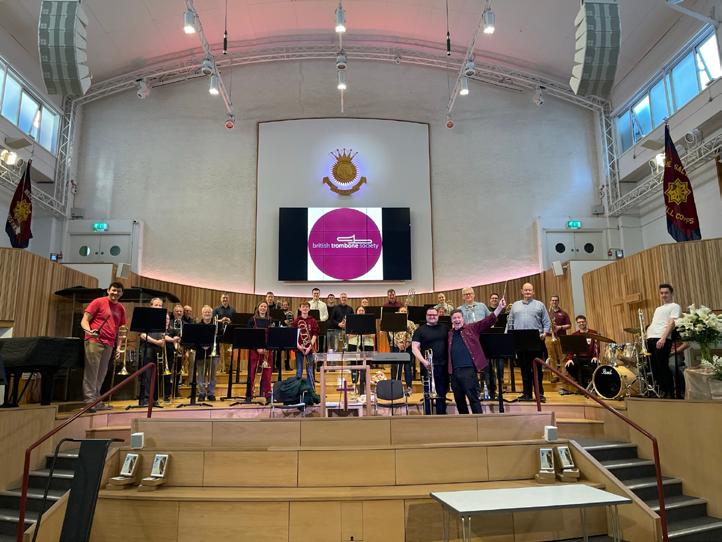
Peter Gane and Richard Ward directed the massed ensemble through Layla and Someone to Watch Over Me from the London Trombone Sound and some of Tutti’s Trombone hits: watch a clip of 12 Street Rag here. Also on the set list was Callum Au’s new work Fanfare for the Common Trombonist and a beautiful arrangement of Holst’s Nunc Dimittis from Tom Pilsbury in memory of Tony Parsons.
Remarkably four BTS Presidents were present; Peter Gane, Mark Nightingale, Matt Gee, and Simon Minshall! Peter also brought along some BTS history, including old photos and magazine articles which everyone enjoyed having a look through.
‘Come and Play Two’ will take place on Tuesday, 24 October, once again kindly hosted by Regent Hall.
Also on 19 April the RTE Concert Orchestra, Dublin, recorded Bobby Lamb’s Conversations – Concerto for Trombone and Violin. The soloists were RTE CO Second Trombone Michael Marshall, and RTE CO Leader Mia Cooper. During a break in rehearsals Michael sat down for chat with Bobby: watch their conversation on the BTS Video Channel Conversations will be broadcast later in the year on Ireland’s National Classical Radio Station Lyric FM.
PHOTO CREDIT: HANNAH HUTTONThe Coronation of Their Majesties King Charles III & Queen Camilla on 6 May featured an exceptional number of trombone players.
Inside Westminster Abbey a total of nine trombonists performed during the Coronation Ceremony, three with the Fanfare Trumpets of the RAF, under the direction of RAF Principal Director of Music Wg Cdr Piers Morell, himself a trombonist, and six distributed between the English Baroque Soloists, Coronation Orchestra and Coronation Brass Ensemble.
The Coronation Procession featured musicians from every Regular and Reserve band of all three Services, with a total of more than 76 trombonists taking part: 18 from the Royal Marines Band Service, 13 from Royal Air Force Music and over 45 from Royal Corps of Army Music. The Trombonist spoke to three of the players about their once in a lifetime experiences.
Alastair Warren: When did you find out you would be playing at the Coronation? How did the invitation come about and how did you feel at the prospect?
Jonty Hill: On 8 March I was asked by RAF Music to lead the Fanfare Trumpeters of the RAF for a recording of the new Coronation Anthem Make A Joyful Noise by Andrew Lloyd Webber. The recording took place on the 15 March, with Andrew Lloyd Webber in the studio. Knowing from that point on that I was going to be involved in the Coronation service was very exciting!
Josh Cirtina: His Majesty had asked for an orchestra to be formed from members of orchestras of which he is patron. I was very fortunate to be selected as one of the representatives from the Royal Philharmonic Orchestra, which was truly an honour.
James Buckle: I was first asked to play in the Coronation when an email from the Monteverdi Choir and Orchestras, titled ‘STRICTLY CONFIDENTIAL’, landed in my inbox on 13 January. I was on tour and surrounded by colleagues – I was pretty excited by the prospect and found it difficult to keep my mouth shut! I had forgotten about it completely a month later when another email, this time from the CEO of the Philharmonia, came through just as I was going to bed in San Francisco, telling me I’d been selected to represent the Philharmonia in the Coronation Orchestra as well, thus beginning a stressful few weeks trying to establish whether or not I could do both!
AW: Which ensemble were you playing with?
JH: The principal role of Fanfare Trumpeters of the RAF was to herald TM King Charles III & Queen Camilla with Jacob’s National Anthem Fanfare. We also played the four Recognition Fanfares and Homage Fanfare, composed for the occasion by Dr Christopher Robinson, Parry’s I was Glad, Walton’s Coronation Te Deum, Make a Joyful Noise and the hymns; Praise My Soul and Westminster Abbey.
JC: I was the trombonist/bass trombonist for the Coronation Orchestra. We performed a large amount of the service music and many of the pre/post service items, all in all quite hefty pad for one trombone! We played a range of music; from six of the new works commissioned especially for the Coronation, to older works such as the Coronation Te Deum, and I was Glad, alongside Jupiter from Holst’s The Planets.
JB: I ended up playing bass trombone with both the English Baroque Soloists, under Sir John Eliot Gardiner, and the Coronation Brass Ensemble, playing Bruckner’s Ecce Sacerdos Magnus with the former and Richard Strauss’ Wiener Philharmoniker Fanfare and Byrd’s Earl of Oxford March (arranged by trombonist Matt Knight) with the latter. The EBS were first to perform at the beginning of the pre-service music and the Coronation Brass Ensemble played at the Crowning moment (literally!) and during the final procession.
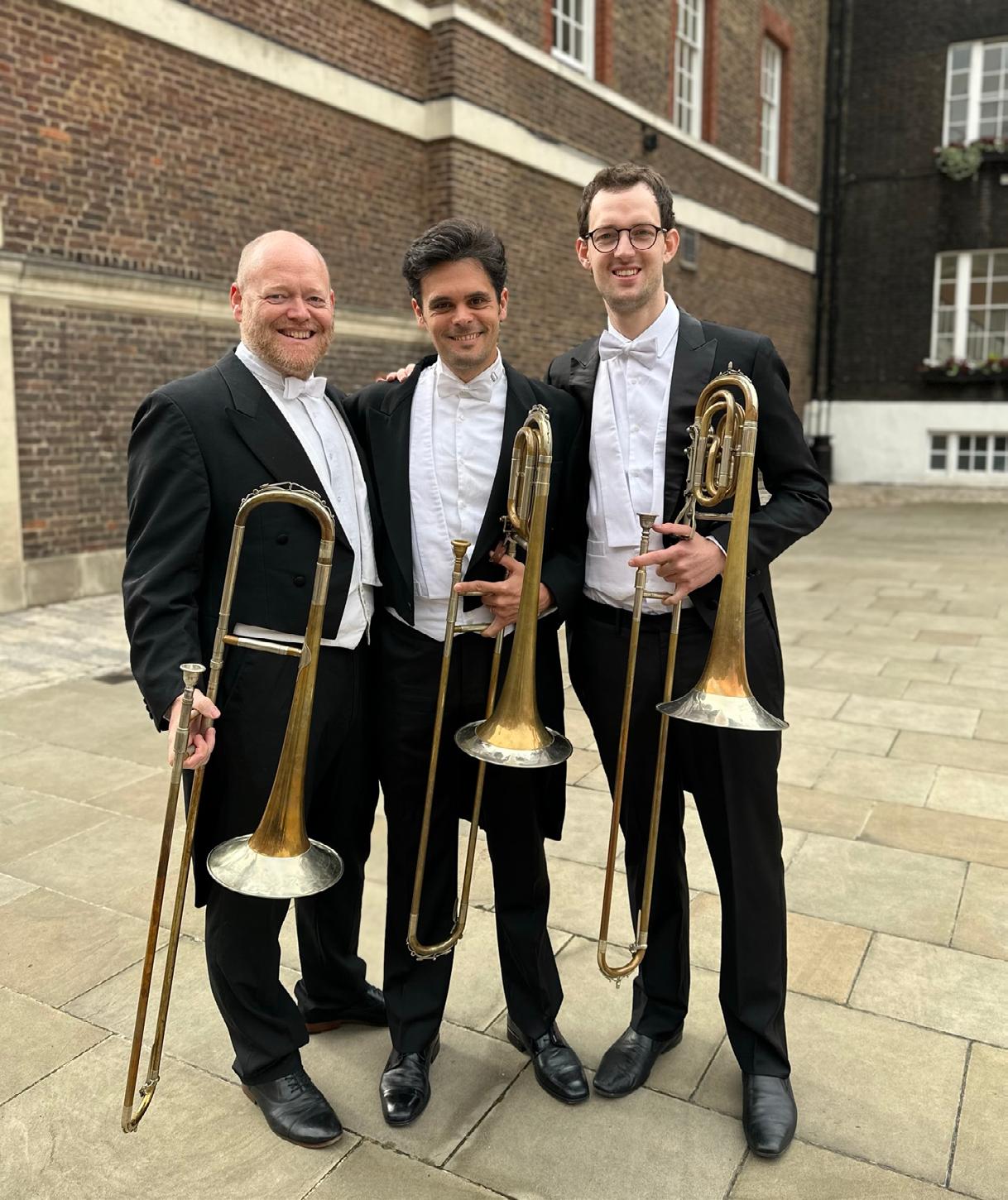
AW: Where were you positioned; did you have a good view of proceedings? What was the atmosphere like?
JH: We were positioned in a gantry built next to the organ loft, just above the Quire. The service was a very emotional experience. One particular highlight was that after we had finished the Fanfare to the National Anthem, we had an uninterrupted view of King Charles III processing through the Sanctuary into the Nave, in full regalia including Crown, Orb and Sceptre. Needless to say, there were tears in this profound and once in a lifetime moment!
We also had an excellent view of the Coronation Orchestra in the organ loft next to us, which sounded
amazing throughout the service, with Josh holding the fort magnificently as the only trombone. Sat opposite us in the Quire below were composers Lord Andrew Lloyd Webber and Sir Karl Jenkins, and baritones Sir Bryn Terfel and Roderick Williams.

JB: It was pretty special to be stood in the middle of the Quire to play the Bruckner with the EBS and Monteverdi Choir. Adam Wolf and Miguel Tantos Sevillano played Alto and Tenor respectively (we used a beautiful set of original instruments lent to us by Adrian France) with the UK’s most senior politicians flanking us on either side, a perfect view of the immaculately presented Thrones being used, and the intense buzz of the congregation surrounding us. During the service the Coronation Brass Ensemble was up to the side behind the fanfare trumpets. Despite a keen Abbey worker telling us we’d have a sensational view we couldn’t see a thing (we were watching on screens)! However, during the processions Pete Smith (tuba) and I snuck to the edge and watched the whole thing with a birds-eye-view. It was sensational and an overriding takeaway was just how beautiful and sparkling the jewels were in real life. The TV really doesn’t do them justice.
The musical highlight for me was getting to play the Bruckner, which I’ll never forget. The standout moment
though was playing the Strauss Fanfare as His Majesty was crowned. That will be something I can show the grandkids one day!
JC: The orchestra was crammed into the organ loft, right in the centre of the Abbey. There wasn’t much room to move at all, and we all had to enter in single file up a tiny staircase, but the view was pretty spectacular. The atmosphere amongst the musicians was very much of excitement and anticipation, and perhaps some nerves too with so many eyes from around the world watching us (not to mention all being recorded for an album, released the same day!)
AW: The public side of the Ceremony was viewed by 20 million; could you take us behind the scenes?
JC: As you can imagine security was very tight with X-Ray scanners at the gate and a 7.45am check in, before the pre-service music began around 9.50am. Once up in the organ loft, we weren’t allowed to leave and toilet breaks were only permissible in extreme circumstances. However, it was all extremely well-organised by the RPO management and Civil Servants, so everything ran like clockwork on the day, which is good, considering we had been rehearsing the programme for 5 days (unheard of in normal London orchestral life)!
JB: As the others have said, the security was tight and when I arrived for my 6.30am call time there was
already a 30-minute queue for the airport style scanners. I encountered difficulty getting from performing with EBS and using one dressing room to getting to the Coronation Brass Ensemble in another – the security took a while to believe that I needed to be in two places at once and in the end, I just had to take a gamble that they wouldn’t use the guns they were holding! The experience was great and what an advert for the sensational level of music making in Britain – a huge thanks to the amazing orchestra stage team of people from across London’s orchestras, and to James Williams and David Whelton who organised the whole thing. Final takeaway – meeting the King on the Thursday and having the opportunity to personally thank him for his unwavering support to the classical music industry and specifically our wonderful orchestras.
JH: We arrived at the Abbey by minibus at about 7.45am. We had a changing room in Westminster school, just off the beautiful school hall, which we were able to use as a warm-up space. We shared the hall with the Coronation Brass Ensemble, and it was nice to catch up with Helen Vollam and Matt Gee before the service. The service began at 11.00am and we were lucky that we didn’t need to take our position in the Gantry until 10.30am, whilst the congregation had been sat down at 9.00am (some as early as 7.00am!).
Our Gantry was carpeted with the same blue carpet that TM The King & Queen processed on and was big enough to accommodate us and the Coronation Brass Ensemble. We had the best spot in the Abbey when they played the Wiener Philharmoniker Fanfare as the King was crowned, and they sounded awesome!

On leaving the Abbey at 1.30pm we had a police ‘blue light’ escort of seven outrider motorcycles to get us out of London past all the road closures/traffic so we could get to Windsor Castle in time for the dress rehearsal of the Coronation Concert. All in all, a very exciting day!◆


Richard Steggall is a well-respected horn player, Principal Horn with the National Symphony Orchestra and a busy West End pit musician, but, like many of us freelancers, he makes a good chunk of his income teaching and making music as an educator.
During his teaching career he has come across many students who have been started off on the horn by a non-specialist. Those of you who teach trombone, or who have been taught by a ‘valver’, know not having a foundation of specialist knowledge during those formative starter years can lead to tricky problems that take a long time to fix. In an ideal world all players would be started off by a trombone/horn/trumpet specialist accordingly and we, as trombonists, would only teach trombone students, but here on Earth that doesn’t happen (I was started off by a tuba player)!
Many brass teachers are put off teaching the ‘weird instruments’ like trombone and horn or they teach it while learning as they go alongside the student. I know I’m guilty of this in the case of horn in particular!
THANK GOD we now have a fantastic new resource to help us. Richard wrote Don’t Fear the Horn especially for us, the freelance/school/music service brass teacher who has to teach all instruments, and it’s fantastic!
The book is a comprehensive guide to the horn, it’s idiosyncrasies and how to teach it. It goes through the history of its creation, the science of how it uses the harmonic series (if you really wanted to, you could skip these in-depth paragraphs and just look at the charts but I, a nerd that talks about the harmonic series to all my students, loved reading about it), how to hold it, maintain it and tips on how to handle mixed teaching groups and ensembles from beginners to youth orchestra sectionals. There are a plethora of helpful photographs, diagrams and music examples as well as horn specific warm-ups at the back of the book. The chapter on how to identify a horn by sight and ‘the F test’ alone would have been enough to convince me to buy the book: there seems to be an endless number of variations of horns out there, of which I had no idea before I started teaching.
I’ve honestly learnt so much, I feel so much more equipped to teach the horn with more authority. Every brass teacher should have this on their shelves, better yet the PDF copy on their tablet ready to consult should you come across a student with a specific horn question. More good news, in communication with Richard, he tells me there are accompanying YouTube videos on the way as well. My next question: who is going to write the one for trombone?
Steph Shore is a trombonist and educator based in London, working as a session player, she enjoys playing in orchestras, in theatres and in jazz orchestras and is currently on tour with Symphonica feat. Mr Switch. ◆
Mention the words ‘Focal Dystonia’ in earshot of a group of trombonists and you are likely to invoke one of three reactions; a blank expression, a sage-like, sympathetic nod, or a look of horror accompanied by a sign of the cross. Without doubt, there is an air of mystery around the condition and its cause or causes, which are not generally explored (often in a fit of anxiety and desperation) until the individual is sucked into its vortex.
Focal Dystonia is defined by the Mayo Clinic as ‘a movement disorder that causes the muscles to contract involuntarily. This can cause repetitive or twisting movements. The condition can affect one part of your body (focal dystonia), two or more adjacent parts (segmental dystonia), or all parts of your body (general dystonia).’
In a musician’s case, Task-Specific Focal Dystonia is characterised by involuntary contractions of those muscles involved in the playing of a musical instrument. It is task-specific and initially only impairs the voluntary control of highly practiced musical motor skills. The condition not only affects brass and wind instrumentalists but also pianists and string musicians.
In recent years, an increasing number of fine brass players holding seats in world class orchestras and bands have had the misfortune to experience task-specific focal dystonia. A number have managed to recover or discover coping strategies. However, for some the condition has been career ending.
I was recently diagnosed with focal dystonia but can trace the condition back to my early 20’s – I am now 65 years old. At the time of my dystonia’s first appearance, I was a young musician in the Band of Her Majesty’s Royal Marines and playing Principal Trombone for the Staff Band, Royal Marines School of Music. My playing was going well: I had high personal standards and always followed a daily regime of lots of practice, on average 5-6 hours in addition to rehearsals, which in hindsight was excessive. However, I really enjoyed the variety of wind band and orchestral repertoire that we played and frequently featured as a soloist, which gave me the incentive to practice.
Like many dystonia sufferers, I started having offdays, which became more frequent and severe. The symptoms included air escaping from my corners, movement in the chin, reduced range, difficulty coordinating the tongue and increased bodily tension. Ironically, prior to the start of dystonia, colleagues often commented that I had a ‘textbook’ embouchure.
My initial reaction was to do more practice – which normally included at least an hour of warming up. This didn’t improve matters and in fact made the symptoms progressively worse. Following an orchestral concert, during which my playing seemed to close down on me, panic started to creep in. This quickly led me to seek advice from colleagues, brass teachers in the School of Music and in London and a period of study with John Ridgeon, an embouchure specialist. The advice I
received was very much in line with pedagogy at the time and helped enough for me to make a partial, but not what I felt was a full, recovery.
Looking back at that first episode of dystonia, in addition to my intense practice routine, I was under a fair amount of pressure in my work and personal life, which may have been the trigger. Without doubt, the drop in performance standard damaged my confidence and self-esteem and contributed to my downward spiral into dystonia. I also became extremely sensitive to any remark from colleagues that suggested, directly or indirectly, that I was not up to scratch. This experience seems to be common amongst dystonia sufferers. Something conscious or unconscious colliding with incremental and undesirable changes in their playing.
Sadly, over the years, dystonia has reared its head on a number of occasions, mainly because I didn’t know what I was dealing with or how to manage it. At the height of my dystonic experience, I would lift the trombone to my lips and my mind would be totally blank. It was as though I couldn’t remember how to form an embouchure or blow, never mind start a note. I started to fear playing and would shy away from opportunities to perform. From listening to the testimony of fellow sufferers, I gather this experience is not uncommon. I was, however, very fortunate to take a series of lessons as part of a degree course with the then Principal Trombonist of the Royal Liverpool Philharmonic Orchestra, Kevin Price. Kevin picked up on aspects of my dystonia and was able to successfully support me as I prepared for my final year recital. Luckily, by this stage, my career in the Marines had progressed to a point where I was moving into managerial roles and playing was taking more of a back seat.
There is a strand of thought that suggests focal dystonia is a neurological condition and very difficult to treat successfully. Going down the neurological route often involves treatment options, including pharmacological interventions such as Botox. However, there are alternative views. One such view is that focal dystonia is an emotional condition that can be treated by working on the underlining symptoms and tensions in a holistic way. Readers may be interested to explore the work of the late Dr Joaquin Fabra, who featured in the Spring 2015 edition of The Trombonist. You can view a series of videos featuring Dr Fabra on Youtube
As for my journey to recovery, which is still ongoing, I was very lucky to hear about the work of Jan Kagarice, who in addition to being a distinguished academic and bass trombonist, is the founder of Musician’s Wellness of North America L.L.C.

Through the work at MWNA, Jan and her team have successfully assisted in the retraining of hundreds of professional musicians diagnosed with Musician’s Dystonia. Her clients include members of some of the most prestigious ensembles across the globe. Jan has also developed an online course for Musician’s Wellness at the Royal Academy of Music in London.
The vision of MWNA is to eradicate task-specific focal dystonia by educating instrumentalists in healthy motor acquisition through a series of bespoke retraining. Given my location, I have been able to connect via Skype with Jan and one of her clinicians, Bobby Fisco, on a regular basis and receive excellent training and support. Retraining requires persistence, discipline, and belief in the process, but the rewards are there.
A major part of recovering from dystonia is realising that you are not alone. It can be an anxious and frightening experience. I found reading through case studies of musicians who have faced dystonia and successfully come out the other side to be enlightening and comforting in equal measures. For anyone suffering from, or with an interest in dystonia, I would encourage you to read Logan Chopyk’s paper, Memoir: successful retraining after musician’s dystonia. It is a fabulous personal account of how Logan, a busy working professional trombonist, went from collapse of playing ability, through retraining to recovery.
What would be my advice to anyone who suspects they may be experiencing dystonic symptoms?
Without doubt, seek guidance as soon as possible. There is a better understanding of dystonia and how to retrain your way out of it than when I first experienced the symptoms. Please remember, you are not on your own and that there is a road to recovery.◆
David Thornber is joint BTS North East Representative.with encouraging young people who might not “look like a stereotypical trombonist”. It’s worth noting that we are seeing a lot more female trombonists in youth organisations and appointed to prominent teaching positions… I have such admiration for the younger generation today, as I teach on various courses around the UK and see a lot more diversity and inclusion amongst that age group. I feel that in their hands… we are heading in the right direction to a more inclusive world.’
The BTS is proud to have one of our own taking a leading role at the forefront of the trombone world and we wish Carol every success during her tenure.
Dudley Bright has been awarded the 2023 ITA Neill Humfeld Award for Excellence in Trombone Teaching.
Dudley was Principal Trombone of the London Symphony Orchestra from 2001–2018, having previously held the same positions with the Hallé and Philharmonia. He is presently professor of trombone at the Royal Academy of Music and leads a busy freelance life, appearing as guest principal with London-based orchestras and in a variety of recording projects.
He made his solo debut with the International Staff Band of The Salvation Army (ISB) at the age of 14 and went on to be featured as soloist widely in the Salvationist world, making several solo recordings.
Carol Jarvis, BTS Past-President and 2021 Sheila Tracey Award winner, has taken up the Presidency of the International Trombone Association, a position she will hold for the next three years.
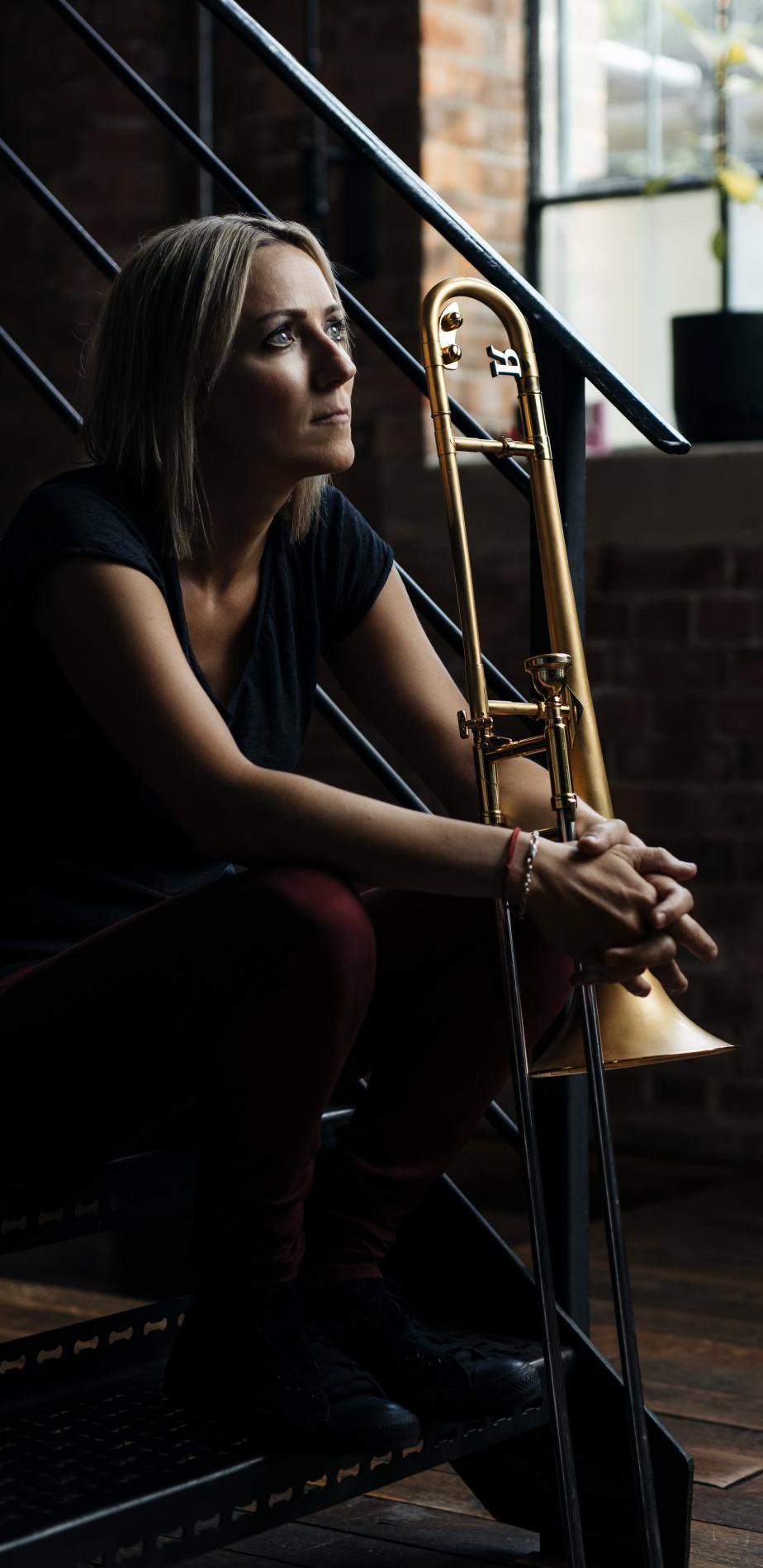
Addressing the ITA membership with a message of inclusivity, Carol said, ‘It is a great honour to have been voted into this position, and to be the first female president in the ITA’s 51-year history is another honour for me. It also shocks me I am the first!… In terms of inclusion, it takes a multi-tiered approach, starting
Dudley has been a trombone design consultant for both Besson and, more recently, Courtois instruments. He is the composer of many works for brass, mainly for the Salvation Army, but also four major secular works. Pursuing the Horizon, written for the LSO’s Brass Academy in 2004, was adapted for brass band and renamed Pursuing Horizons. It was performed at the Royal Albert Hall by more than 250 players to celebrate the 120th anniversary of the ISB.
Dudley received the BTS Outstanding Achievement Award in 2020.
PHOTO CREDIT: TOMMY REYNOLDS.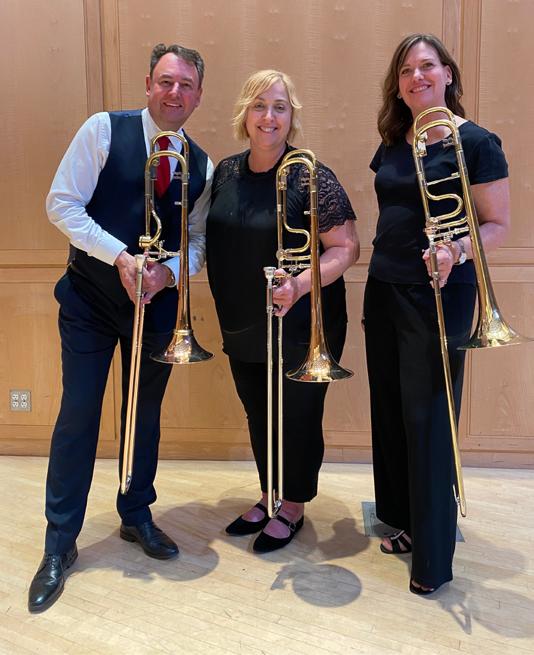

The UK was well represented at the ITF 2023 by Katy Jones and Dr Brett Baker. Carol Jarvis, who in addition to her new role as ITA President has been President of the ITF since 2017, was kept busy interviewing the performing artists, including Katy; interviews can be viewed on the ITF Facebook page.
Katy and Brett sent us a postcard each describing their experiences at the ITF.
Once I’d got over the initial shock of 35-degree heat with very low humidity I met with my lovely accompanist for a rehearsal. I learned plenty about Salt Lake City, including all the essentials such as where best to eat, and how many breweries there are (30 at last count!). In amongst the huge amount of guest recitals to attend, and the rehearsals for our own performances, there was also a Youth Workshop running alongside the whole event, and I got the chance to work with them too. I performed Andrew Duncan’s Concerto, which was originally written for my predecessor in the Hallé, Andy Berryman, on ‘Concerto Night’. Only 16 hours later came my recital in the same concert hall with an accompanist who had only just finished an incredible ‘roast up’ with Faustino Diaz. If you haven’t heard this name – look him up! Wow!
On the final day I gave a lecture on ‘Breathing is for Life and not just the Trombone’ based on my experiences working with the Buteyko Breathing Method alongside other research. This stimulated some great questions, and was also recorded for the ITF app.
Highlights of the week: listening to Marshall Gilkes (former Visiting Professor at RNCM) play his new album, Cyclic Journey, with a great group of musicians; the fact that Bill Reichenbach was there all week (what a legend!); and the Slide Monsters concert at the close of the festival, featuring Brandt Attema (new Visiting Professor at RNCM) alongside Joe Alessi, Marshall and Eijiro Nakagawa. Huge thanks must go to all the accompanists for their heroic note learning efforts, and to the organisers for the fact that the event ran so smoothly, including our very own ‘President’ Carol Jarvis!
Katy JonesEach year, the ITF draws hundreds and hundreds of trombonists from around the world. I had the pleasure of performing as an Artist at this year’s Festival as a Michael Rath representative. ITF is inspirational for me, it gives me new ideas, new music to practice and of course the chance to meet up with old friends including Mick himself on the trade stand. One of the highlights for me was judging the Smith soloist competition; the standard of playing was immense and a joy to experience.
Highlights were on Thursday listening to Isrea Butler’s recital (Lead Trombonist with Count Basie Orchestra) and to my colleagues in the ‘Concerto Night’: Faustino Diaz playing the Bourgeois Concerto, Katy Jones playing the rarely heard Andy Duncan Concerto and Mark Davidson playing Blues Bells of Scotland by Pryor. I played a new piece entitled Light Fantastic by Philip Wilby: we were all accompanied by a double quintet and the players were exceptional.
On Friday I enjoyed Dave Vinings talk about breathing and posture, Ko-Ichiro Yamamoto’s (Seattle Symphony) recital and without doubt Joe Alessi’s recital with organ showcasing material from his new CD De Profundis. It really was a masterclass in how to perform. I love listening to the latenight jazz sessions and this Festival was no exception.
On Saturday I was preparing for my own recital session but got to listen to Arizona State University Trombone Choir, and the fabulous Bill Reichenbach. Then Slide Monsters took the stage for an immense concert featuring material from their two albums.
It was a memorable festival and due to the performances being streamed and recorded there is an opportunity to hear every single performance. Congratulation to the hardworking team led by ITF Director Karen Marston.
Brett Baker KATY JONES. PHOTO CREDIT: ITF. L-R BRETT BAKER, KAREN MARSTON, DEB SCOTT.As this year’s Proms season draws to a close orchestras around the UK are kicking off their 23/24 seasons with some really colourful and excitingly themed programmes.
For the symphonic picks Josh has chosen a couple of concerts featuring ‘must see’ artists, and then focused on programmes that explore strong themes.
BY JOSH CIRTINA // PRINCIPAL BASS TROMBONE IN THE ROYAL PHILHARMONIC ORCHESTRA SYMPHONIC HIGHLIGHTS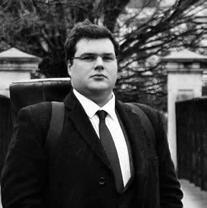
KAZUKI & SHEKU KANNEH-MASON
– CITY OF BIRMINGHAM SYMPHONY ORCHESTRA
7.00pm, Saturday, 16 September
Symphony Hall, Birmingham
A fabulous line up of artists headlines this concert; new Chief Conductor Kazuki Yamada is joined by brilliant young cellist Sheku Kanneh-Mason in this sure-to-be electrifying concert. They star together in Shostakovich’s thrilling Cello Concerto No.1, before the CBSO take us on the white-knuckle roller coaster ride that Walton’s Symphony No.1 – if you’ve not heard this symphony before, don’t miss it!
DAPHNIS AND CHLOE
– HALLÉ ORCHESTRA
7.30pm, Thursday, 5 October
Bridgewater Hall, Manchester
Sir Mark Elder reunites with the Hallé after so many years at the helm for a richly colourful programme.
Sibelius’ impressionistic The Oceanides opens the concert evoke images of the sea and nymphs from Greek mythology, before newly appointed leader of the Halle, Roberto Ruisi, performs Stravinsky’s neo-baroque Violin Concerto. For the grand finale the Hallé Choir join the orchestra for a complete performance of Ravel’s Daphnis and Chloe. A ballet of deep sensuousness and a glorious spectrum of colours.
BEETHOVEN & STRAUSS
– ROYAL SCOTTISH NATIONAL ORCHESTRA
7.30pm, Friday, 6 October
Usher Hall, Edinburgh
7.30pm, Saturday, 7 October
Royal Concert Hall, Glasgow
A blockbuster of a season opener – enjoy Music Director Thomas Søndergård and the RSNO on full throttle with Strauss’ Ein Heldenleben. Translating as ‘A Hero’s Life’, this is a work of sonic drama – heroism & young love told with a huge orchestra. Preceding this is Dorothy Howell’s Lamia and Beethoven’s stormy Piano Concerto No. 3, with soloist Lise de la Salle.
LANG LANG
– ROYAL PHILHARMONIC ORCHESTRAS
7.30pm Tuesday, 21 & Thursday, 23 November Royal Albert Hall, London
Don’t miss this opportunity to see and hear one of the world’s greatest pianists, accompanied by the RPO, conducted by Mark Wigglesworth. In a concert celebrating the composer Saint-Saëns, Lang Lang performs his Piano Concerto No. 2 and Carnival of the Animals. Also on the programme is Wagner’s Tannhauser Overture and Ravel’s Mother Goose Suite. This is surely one of the most characterful programmes we will see all season.
7.00pm, Thursday, 23 November Barbican, London
As the LSO guide suggests, this programme, conducted by Duncan Ward will ‘sweep you off your feet’. Opening with Isabelle Faust as soloist in Bartók’s Violin Concerto No. 1; dedicated to Stefi Geyer whom Bartok had a crush on… but she refused to return this adoration and never played it herself. Continuing the theme of doomed romance, Janáček’s Taras Bulba is a rousing tale of a pair of lovers on opposing sides in a battle. Chausson’s Poemé was inspired by a short story about two men in love with the same woman before we conclude with Debussy’s beguiling La Mer – it’s a portrait of the sea that he wrote whilst he was in the midst of an adulterous affair.
PLAYING PICASSO
– BBC NATIONAL ORCHESTRA OF WALES
7.30pm, Friday, 8 December
Hoddinott Hall, Cardiff
I really like this programme concept; ‘Known as one of the most influential artists of the 20th Century and for co-founding the Cubist movement, it is surprisingly little known that the artist Pablo Picasso was heavily involved in the costume design for many groundbreaking ballets.’ Here in a lineup of Stravinsky’s Pulcinella & Ragtime along with Satie’s Parade and de Falla’s Three Cornered Hat – Suite No. 2, the BBC NOW, led by conductor Ryan Bancroft, take us on a musical journey tied together by Picasso’s links to the enchanting world of Ballet.
BY BECKY SMITH // PRINCIPAL TROMBONE AT THE ENGLISH NATIONAL OPERA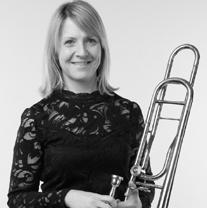
Most main stage opera houses begin their season in September, so you will often find fewer performances right at the start of the month, increasing as rehearsal periods finish and the actual runs start, overlapping as different shows are performed concurrently.
However, if you need your opera fix at the start of September then I urge you to get to the Royal Albert Hall in London on Sunday, 3 September for a concert performance of Berlioz’s Les Trojans, as part of the BBC Proms season. This is an epic opera in five acts and one that Berlioz felt was his greatest work. It is performed by the Paris based Orchestre Révolutionnaire et Romantique conducted by Sir John Eliot Gardiner with a great cast including Alice Coote and Michael Spyres.
The Royal Opera House in London marks the start of a new Ring Cycle with Das Rheingold, so if you are a Wagner newbie this is your chance to see what it’s all about, especially as it is one of the shorter Wagner operas (running time is 2 hours 20 minutes with no interval). Performances take place throughout September.
Opera North are touring Verdi’s Falstaff, an energetic, comedy and a good one for trombonists. Verdi composed for valved instruments, and he did write a lot of fast notes! Nowadays it is rare to see a section of valve trombones; players (definitely here in the UK anyway) prefer to use the standard slide trombone meaning there
are always a few passages to keep us on our toes. They will perform this opera in Leeds, Nottingham, Newcastle and Salford Quays between 28 September and 18 November.
English Touring Opera have a busy Autumn season, with performances all over the UK of Rossini’s Cinderella, Monteverdi’s Coronation of Poppea and one for young children called Under the Little Red Moon. This looks to be a great introduction for ages 6-24 months, exploring the development of language through music and movement.
With Welsh National Opera and Glyndebourne Touring having to cancel either part or the whole of their seasons, it is good to see ETO carrying on their brilliant work. Let’s hope that funding is reinstated and we get back to having more opera being performed all over the country.
Finally, after a stressful few months of not knowing the future of English National Opera, (as with WNO and Glyndebourne Touring this is funding related),
I am very much looking forward to a run of Britten’s Peter Grimes across September and October with the company at the Coliseum in London. Some fabulous writing for the whole orchestra, with a stellar cast and my first time performing it, I can’t wait!◆
DENNIS ROLLINS
8.00pm, Wednesday, 13 September
Peggy’s Skylight, Nottingham
NATIONAL BRASS BAND CHAMPIONSHIPS
Section 1-4 Finals
10.00am, Saturday, 16 September
10.00am, Sunday, 17 September
Cheltenham Racecourse
Championship Section Final
10.00am, Saturday, 21 October
Royal Albert Hall, London
MARK NIGHTINGALE & ALAN BARNES QUINTET
8.00pm, Sunday, 17 September
Apollo Theatre, Isle of Wight
MATTHEW GEE
UK première of Nico Muhly’s All Perfections Keep for solo trombone and string quartet
7.30pm, Friday, 22 September
Kings Place, London
MARK NIGHTINGALE & ALAN BARNES SEXTET
8.45pm, Sunday, 24 September
Scarborough Spa, Scarborough
8.00pm, Tuesday, 28 November
PizzaExpress Jazz Club (Soho), London
RORY INGHAM’S TROMBONE ASSEMBLY
4.00pm, Sunday, 24 September
Scarborough Spa, Scarborough
8.00pm, Tuesday, 17 October
The Harlington, Fleet
HANNABIELL & MIDNIGHT BLUE
8.00pm, Wednesday, 27 September
Peggy’s Skylight, Nottingham
BONES APART TROMBONE QUARTET
7.30pm, Wednesday, 27 September
Peak Music Society
Cavendish Hall, Derbyshire
SLIDE ACTION
Rebuilding the Trombone
1.00pm, Friday, 29 September
Elgar Concert Hall, Birmingham
ENGLISH CORNETT AND SACKBUT ENSEMBLE
7.30pm, Friday, 29 September
Kings Place, London
7.30pm, Thursday, 9 November
Stoller Hall, Manchester
7.30pm, Saturday, 18 November
All Saints Weston, Esher, London
2.00pm, Friday, 24 November
St Paul’s Church, Knightsbridge, London
THE VOICE OF THE SOPRANO TROMBONE
Torbjörn Hultmark presents a concert of acoustic and electroacoustic music featuring the soprano trombone
7.30pm, Thursday, 5 October
Royal Birmingham Conservatoire, Birmingham
GEORGE SIMMONS SQUINTET
7.00pm Wednesday, 11 October
St Martin in the Fields Crypt, London
MARK NIGNTINGALE & CALLUM AU
8.00pm, Thursday, 19 October
Piano Smithfield, London
ELAINE DELMAR & THE MARK NIGHTINGALE BIG BAND
1.00pm and 8.00pm, Sunday, 29 October
PizzaExpress Jazz Club (Soho), London
RORY INGHAM SEXTET
7.45pm, Friday, 10 November
1000 Trades, Birmingham
6.30pm, Sunday, 12 November
The Jazz Sanctuary, Twickenham, London
8.00pm, Monday, 13 November
Spice of Life, Soho, London
BRASS IN CONCERT FESTIVAL
World of Brass in Concert featuring Isobel Daws, BONE-AFIDE trombone quartet and
Fountain City Brass Band
7.45pm, Friday, 17 November
Brass in Concert Championship
11.00 am, Saturday, 18 November
The Sage, Gateshead
MARK NIGHTINGALE & TERRY HUTCHINS QUARTET
7.30pm, Sunday, 3 December
Pangbourne Jazz Club, Pangbourne
SLIDESHOW TROMBONE QUARTET
Live Music Now emerging artists
11.00am, Monday, 4 December
Usher Hall, Edinburgh
BONA-FIDE TROMBONE QUARTET
3.00pm, Sunday, 17 December
Gulbenkian Arts Centre, Canterbury
Also streamed
Do you know of an event that should feature in our next publication?
LET US KNOW

